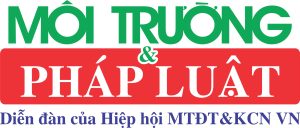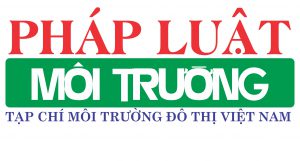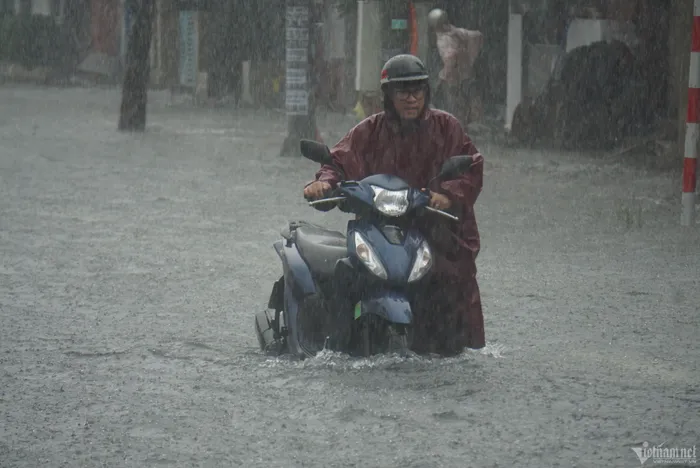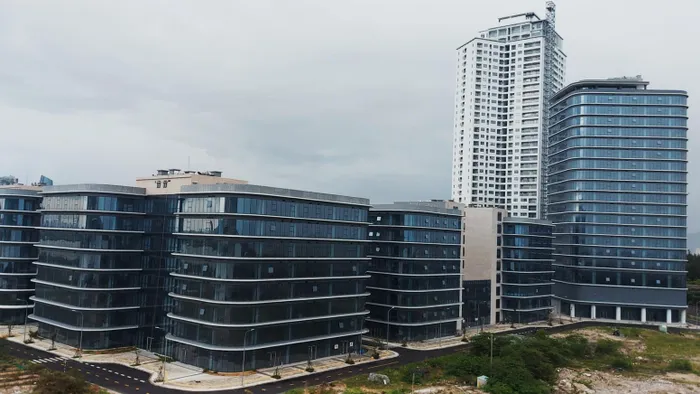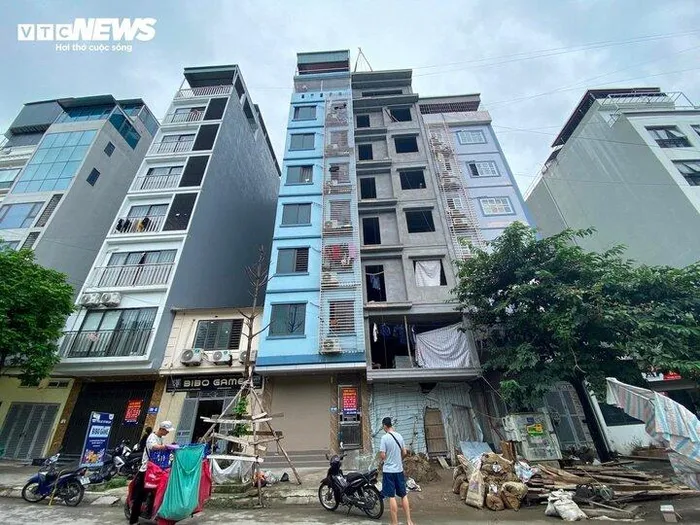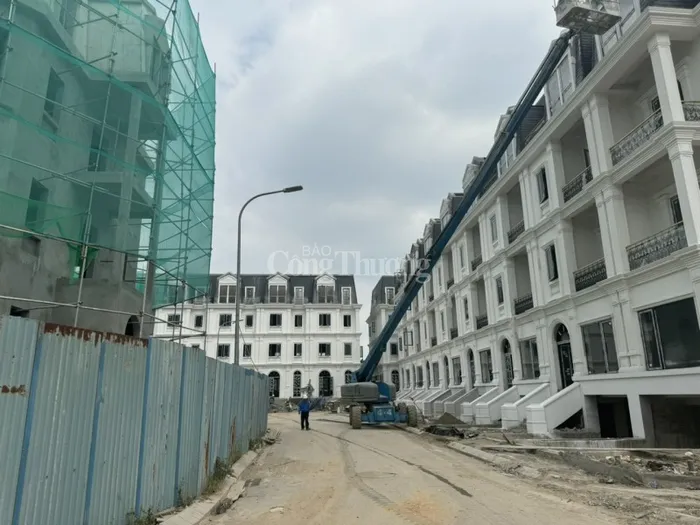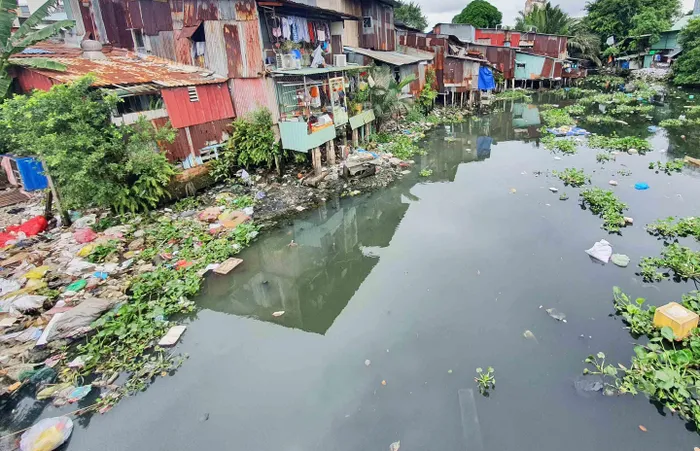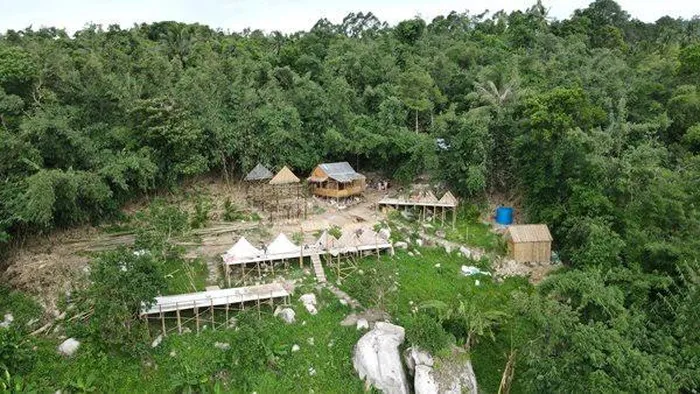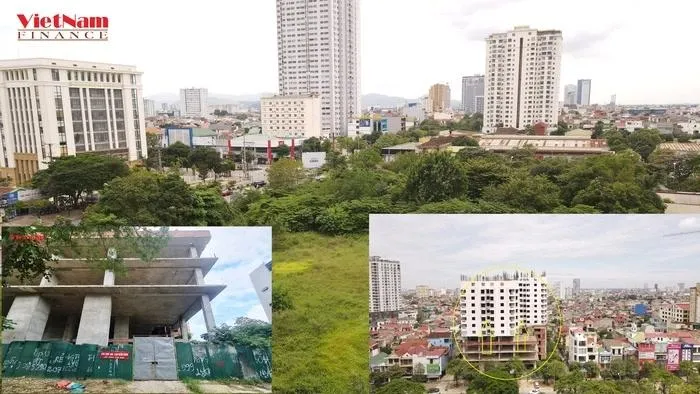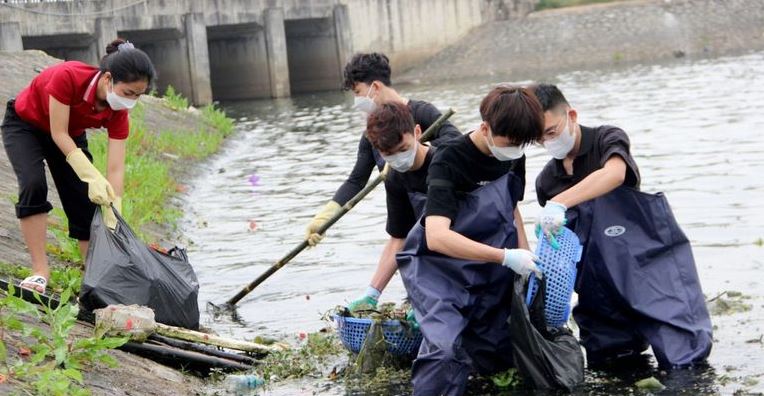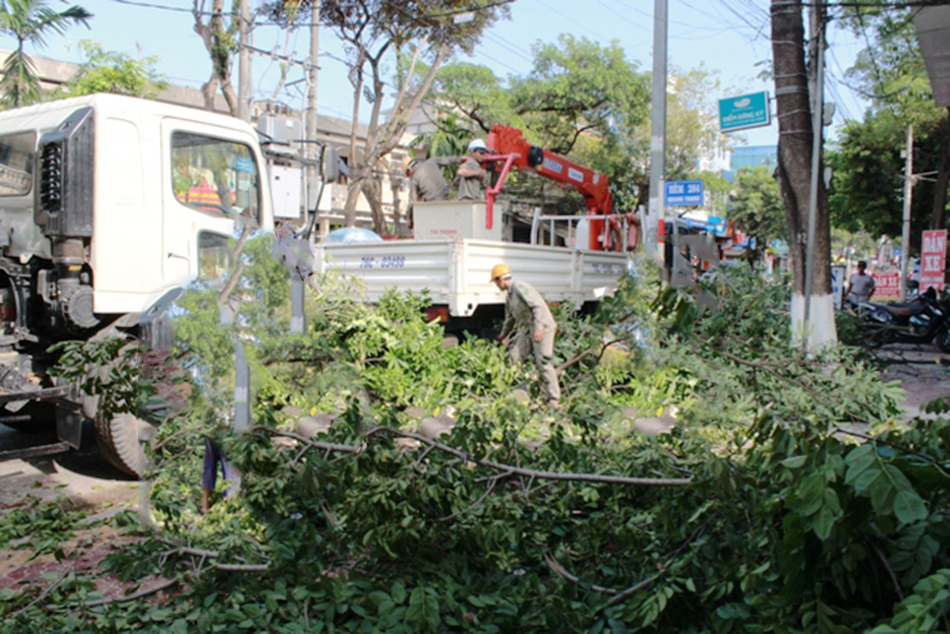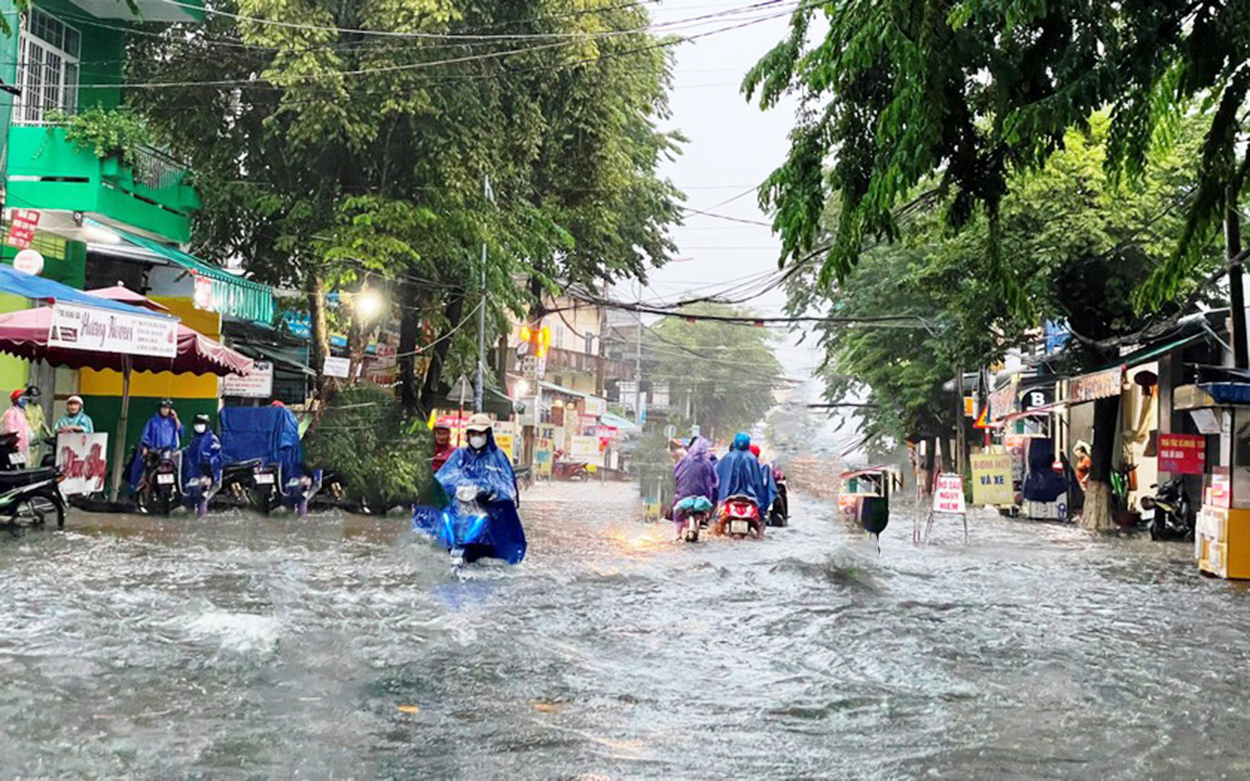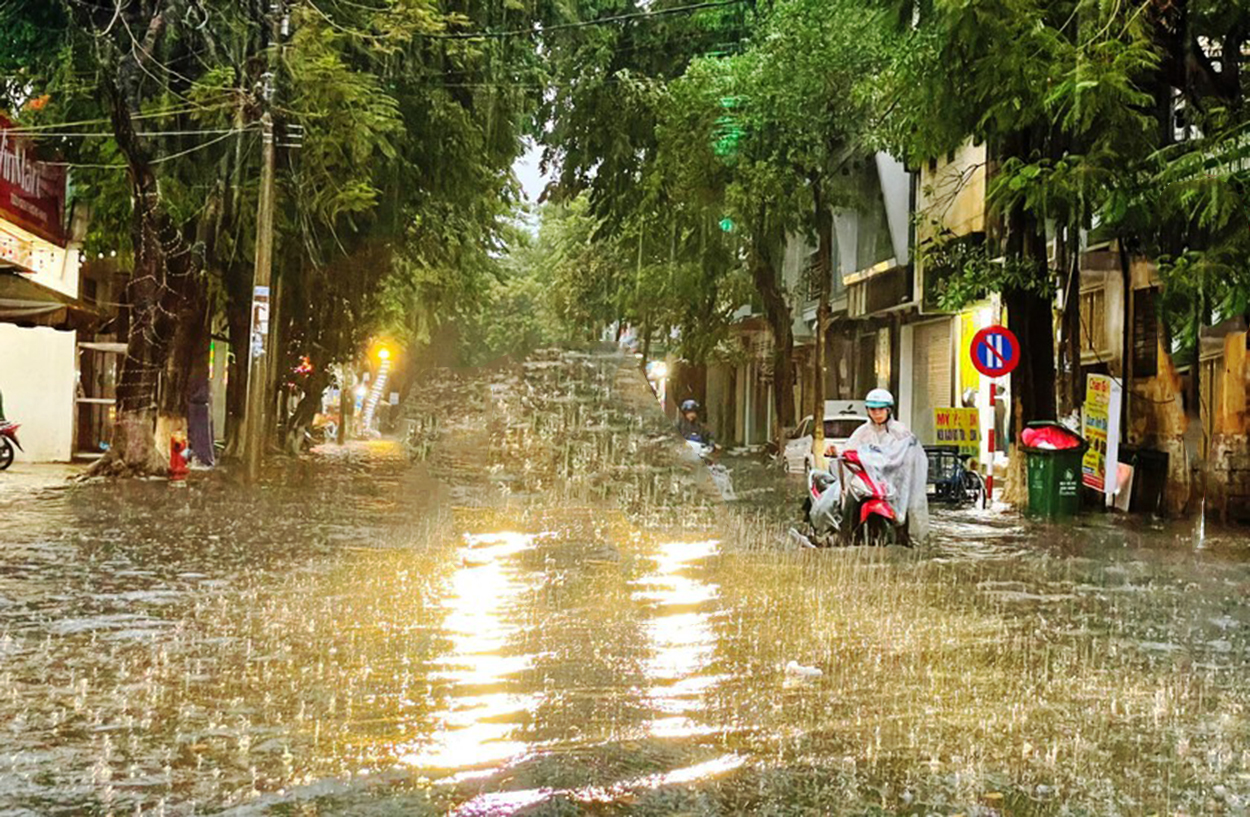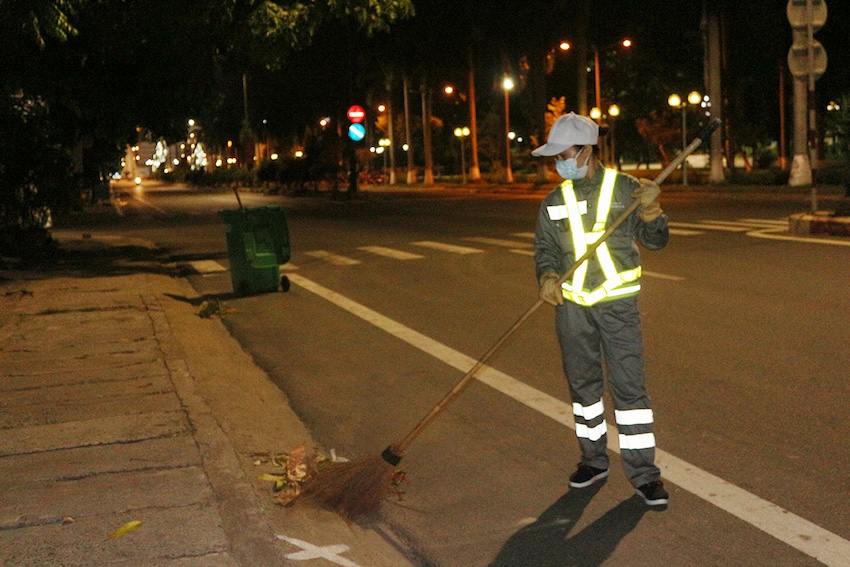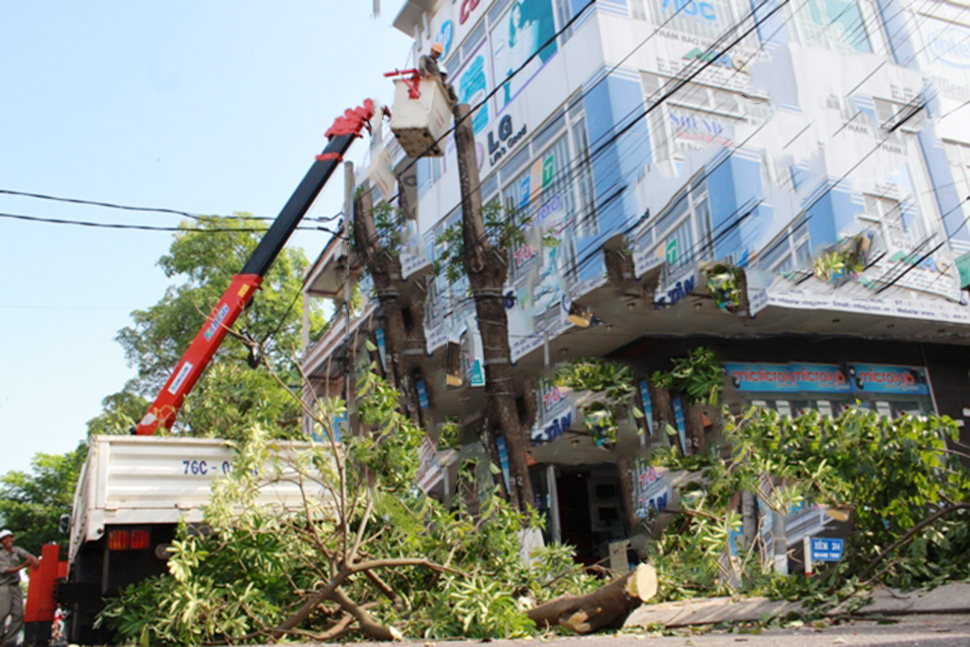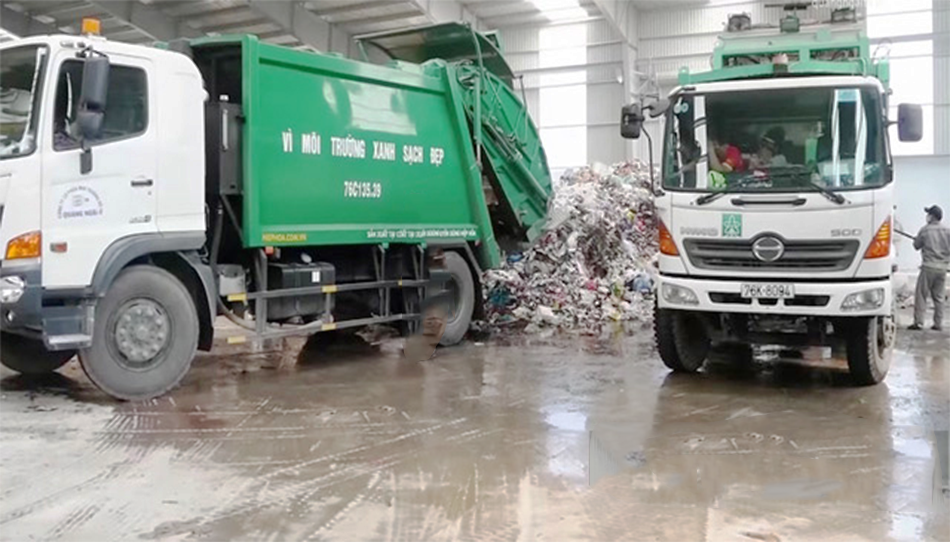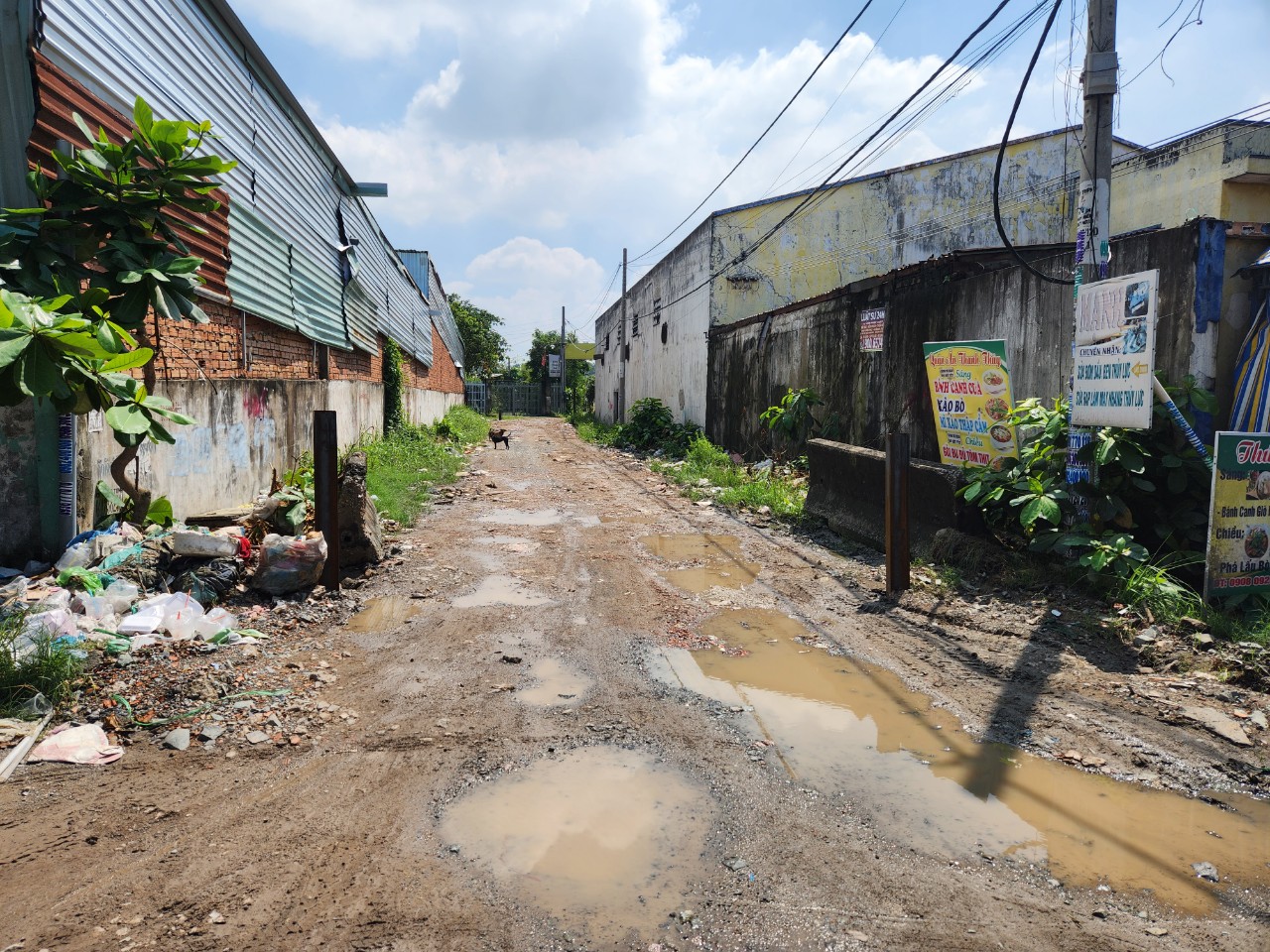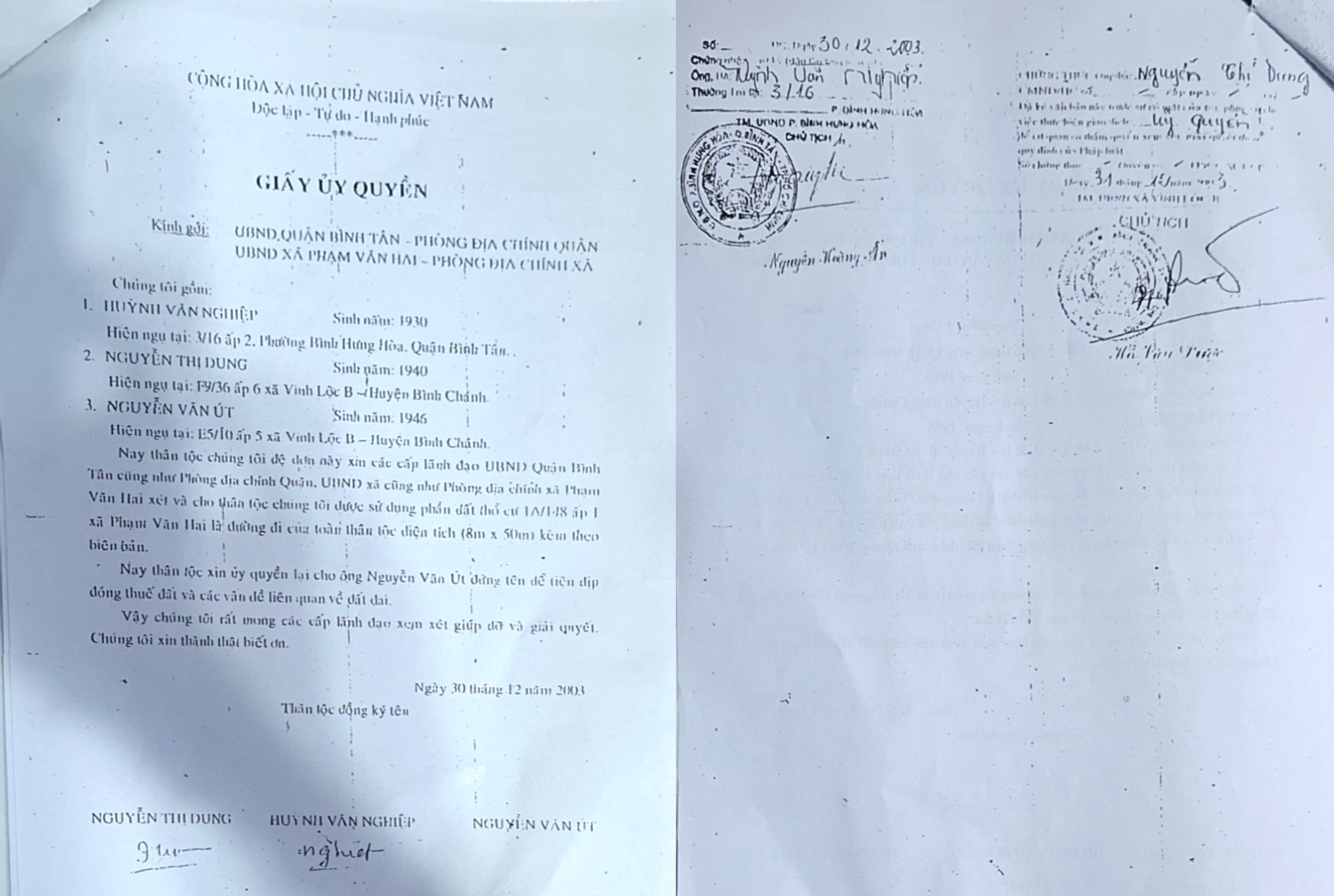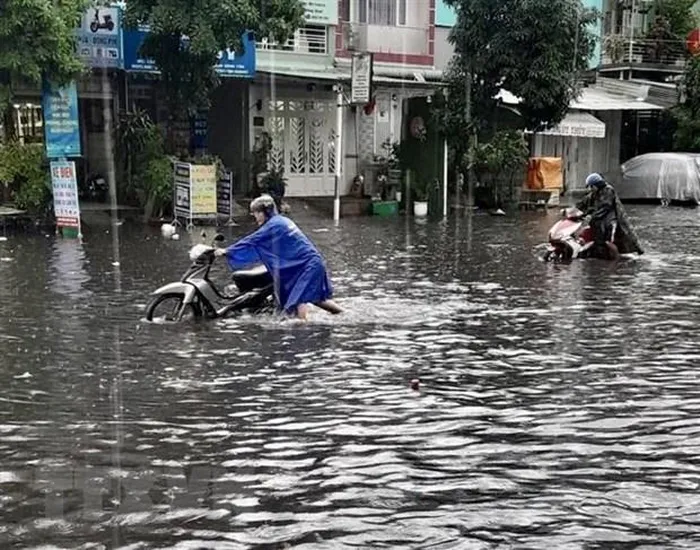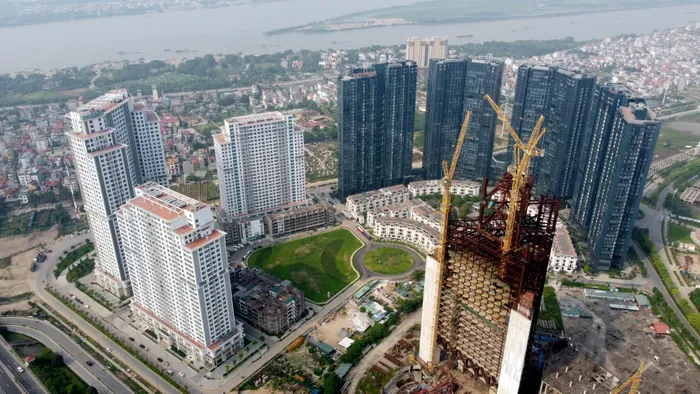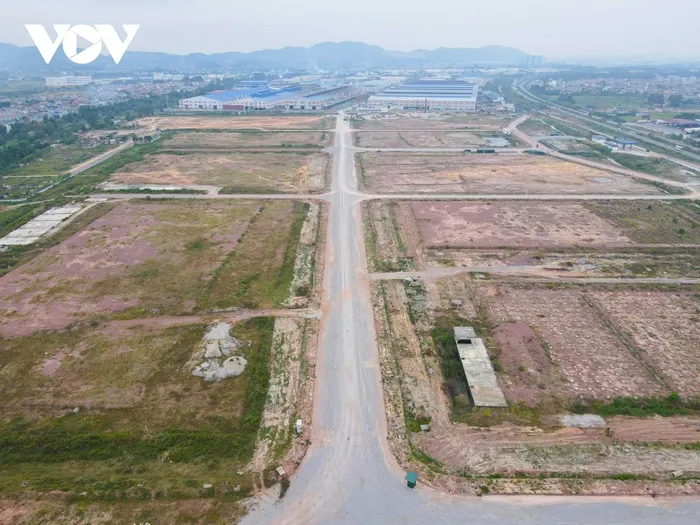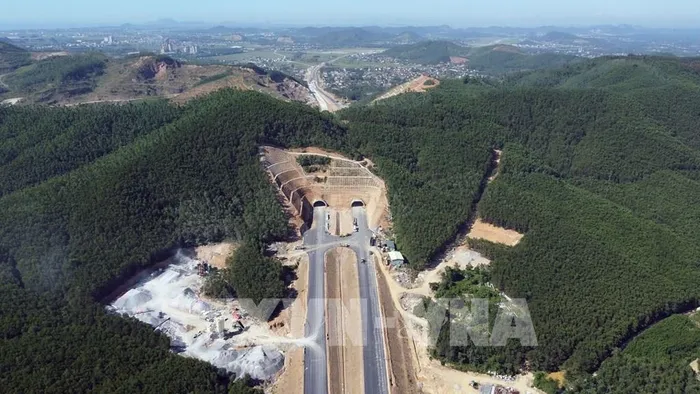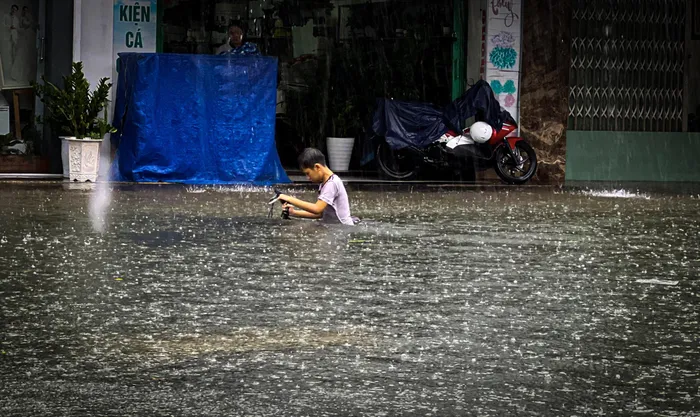Trân trọng giới thiệu tới quý độc giả Công bố quốc tế lĩnh vực môi trường số 39-2023 với những nội dung chính như sau:
Pleased to present to our valued readers the International Environmental Bulletin No. 40/2023, featuring the following key topics:
Về quản lý môi trường
– Mô hình hóa chu trình nitơ khu vực trong khí quyển: Tình hình hiện tại và phản ứng của nó đối với chiến lược kiểm soát khí thải trong tương lai.
– Tác động của việc áp dụng các chiến lược không phát thải carbon đối với nồng độ ozone tầng đối lưu (O3) và hạt bụi mịn (PM2.5) ở khu vực Nhật Bản vào năm 2050.
– Hướng tới triển khai các thành phần của tòa nhà hình tròn: Nghiên cứu dài hạn về sự lựa chọn của các bên liên quan trong việc phát triển 8 thành phần của tòa nhà hình tròn.
– Làm sáng tỏ hiệu quả của đổi mới xanh và thuế trong việc thúc đẩy chất lượng môi trường: Đánh giá mô hình kép để kiểm tra lý thuyết LCC ở các nền kinh tế mới nổi.
– Kiểm soát ô nhiễm biên giới: Sự hấp dẫn từ các khuyến khích thúc đẩy chính trị.
– Vai trò của sự phức tạp về kinh tế và sự can thiệp của chính phủ đối với sự bền vững của môi trường: Phân quyền có quan trọng không?
– Nhiệt độ cao, COVID-19 và tỷ lệ tử vong vượt mức trong mùa hè năm 2022: một nghiên cứu đoàn hệ về dữ liệu từ các giám sát của Ý.
– Kết nối các lĩnh vực khác nhau theo nhiều chiều: Quan điểm về khả năng phục hồi của siêu hệ sinh thái.
– Thành phố thông minh có bền vững hơn không? Một nghiên cứu thăm dò về 103 thành phố của Hoa Kỳ.
– Đại dịch COVID-19 đã ảnh hưởng đến dịch tễ học dựa trên nước thải như thế nào?
– Lập bản đồ các xu hướng không gian và thời gian của sự lắng đọng nitơ trong khí quyển ở cấp độ cảnh quan ở Đức 2005, 2015 và 2020 và so sánh chúng với dữ liệu phát thải.
Về môi trường đô thị
– Bài học từ lịch trình cấp nước không liên tục: Hình dung sự bình đẳng, công bằng và năng lực thủy lực ở Bengaluru và Delhi, Ấn Độ.
– Hiệu suất của hệ thống đồng nuôi cấy vi khuẩn bản địa cyanobacteria (BCIB) để thu giữ và chuyển chất dinh dưỡng trong nước thải đô thị.
– Dòng chảy lớn của các chất per- và polyfluoroalkyl (PFAS) trong mạng lưới nước thải đô thị và nhà máy xử lý nước thải của Thụy Điển.
– Kết nối cái cũ và cái mới trong quá trình chuyển đổi bền vững: Vai trò của các bên trung gian chuyển đổi trong việc tạo điều kiện thuận lợi cho thử nghiệm đô thị.
– Kiểm soát ngập úng đô thị: Một phương pháp mới để tái thiết đường ống thoát nước đô thị, có hệ thống và tự động.
– Đánh giá tác động kinh tế của các chính sách quốc gia giảm thiểu biến đổi khí hậu đối với các thành phố: Phân tích CGE ở Auckland, New Zealand.
– Tác động của việc sửa đổi chất hữu cơ đến chất lượng đất và carbon đất đô thị: Một phân tích tổng hợp.
– Các chất ô nhiễm vi mô cơ bản trong bùn từ các nhà máy xử lý nước thải đô thị ở Tây Bắc Tây Ban Nha: Sự xuất hiện và đánh giá rủi ro trong quá trình xử lý bùn.
– Phương pháp ước tính tiềm năng khử cacbon ở cấp độ khu vực lân cận trong khu đô thị: Ứng dụng tại La Carrasca, thành phố Valencia – Tây Ban Nha.
– Mối liên hệ giữa không gian xanh khu phố và kết quả sinh sản đa dạng ở hai khu vực đô thị ở Úc.
Về môi trường khu công nghiệp
– Khám phá những thách thức và giải pháp thông minh trong quản lý chất thải công nghiệp: Phương pháp ra quyết định đa tiêu chí mờ do dự tích hợp.
– Lọc nước thải công nghiệp bằng quy trình dựa trên khí hydrat (HyPurif).
– Nghiên cứu cơ chế về quy trình sạch và có thể tái chế để loại bỏ boron khỏi silicon cấp công nghiệp bằng hợp kim entropy cao CrMnFeNiMe.
– Việc áp dụng các biện pháp bảo vệ môi trường trong các nhà máy bia thủ công: Vai trò của giá trị tiêu dùng, động lực và những thách thức kinh doanh được nhận thức của người chủ-người quản lý.
– Hiệu suất của nhà máy nhiệt điện than sCO2 ở các công suất điện khác nhau.
– Giảm thiểu ô nhiễm dầu khí vì môi trường bền vững – Đánh giá quan trọng và triển vọng.
– Các giá trị bền vững và tối ưu cho nước thải đô thị: Loại bỏ nhu cầu oxy sinh học và nhu cầu oxy hóa học bằng nhiều cấp độ mô phỏng dựa trên thuật toán di truyền và than hoạt tính dạng hạt khác nhau.
– Từ ô nhiễm đến thịnh vượng: Nghiên cứu đường cong Kuznets môi trường và giả thuyết nơi trú ẩn ô nhiễm trong khu vực công nghiệp châu Phi cận Sahara.
– Khả năng khử màu nước thải dệt may của các loài Aspergillus chịu được kim loại và tối ưu hóa nồng độ và nhiệt độ sinh khối.
– Cái nhìn sâu sắc về phân tử về sự chuyển đổi chất hữu cơ hòa tan trong quá trình ủ phân từ bùn thải: Nghiên cứu về một nhà máy ủ phân quy mô lớn.
– Chế tạo hạt nano WO3 dạng hoa phân cấp để cảm nhận ion kim loại hiệu quả và xúc tác phân hủy thuốc nhuộm hữu cơ.
– Tổng hợp và ứng dụng oxit kẽm pha tạp mangan làm chất hấp phụ tiềm năng để loại bỏ thuốc nhuộm đỏ Congo khỏi nước thải.
CHUYÊN TRANG QUẢN LÝ MÔI TRƯỜNG
Tạp chí Môi trường và Đô thị Việt Nam
Xin trân trọng giới thiệu
ENVIRONMENTAL MANAGEMENT / QUẢN LÝ MÔI TRƯỜNG
1. Modeling regional nitrogen cycle in the atmosphere: Present situation and its response to the future emissions control strategy
Science of The Total Environment, Volume 891, 15 September 2023, 164379
Abstract
Reactive nitrogen (Nr) cycle in the atmosphere has an important affection on terrestrial ecosystems, which has not been fully understood and its response to the future emissions control strategy is not clear. Taking the Yangtze River Delta (YRD) as an example, we explored the regional Nr cycle (emissions, concentrations, and depositions) and its source apportionment in the atmosphere in January (winter) and July (summer) 2015 and projected its changes under emissions control by 2030 using the CMAQ model. We examined the characteristics of Nr cycle and found that Nr suspends in the air mainly as NO, NO2, and NH3 gases and deposits to the earth’s surface mainly as HNO3, NH3, NO3−, and NH4+. Due to the higher NOx than NH3 emissions, oxidized nitrogen (OXN) but not reduced nitrogen (RDN) is the major component in Nr concentration and deposition, especially in January. Nr concentration and deposition show an inverse correlation, with a high concentration in January and low in July but the opposite for deposition. We further apportioned the regional Nr sources for both concentration and deposition using the Integrated Source Apportionment Method (ISAM) incorporated in the CMAQ model. It shows that local emissions are the major contributors and this characteristic is more significant in concentration than deposition, for RDN than OXN species, and in July than in January. The contribution from North China (NC) is important for Nr in YRD, especially in January. In addition, we revealed the response of Nr concentration and deposition to the emission control to achieve the target of carbon peak in the year 2030. After the emission reduction, the relative responses of OXN concentration and deposition are generally about 100 % to the reduction of NOx emissions (~50 %), while the relative responses of RDN concentration are higher than 100 % and the relative responses of RDN deposition are significantly lower than 100 % to the reduction of NH3 emissions (~22 %). Consequently, RDN will become the major component in Nr deposition. The smaller reduction of RDN wet deposition than sulfur wet deposition and OXN wet deposition will raise the pH of precipitation and help alleviate the acid rain problem, especially in July.
2. Impact of introducing net-zero carbon strategies on tropospheric ozone (O3) and fine particulate matter (PM2.5) concentrations in Japanese region in 2050
Science of The Total Environment, Volume 891, 15 September 2023, 164442
Abstract
In this study, we estimated the future emission inventory of primary air pollutants in Japan in 2050 after introducing low-carbon technology based on the results of the socio-economic model provided by the Japanese government. The results suggested that introducing net-zero carbon technology would contribute to a 50–60 % decrease in primary NOx, SO2, and CO emissions and a ~30 % decrease in primary emissions of volatile organic compounds (VOCs) and PM2.5. The estimated emission inventory and future meteorological conditions in 2050 were applied as inputs to a chemical transport model. A scenario involving the application of future reduction strategies with relatively moderate global warming (RCP4.5) was evaluated. The results showed that the concentration of tropospheric ozone (O3) was highly reduced compared with that in 2015 after applying net-zero carbon reduction strategies. On the other hand, the fine particulate matter (PM2.5) concentration under the 2050 scenario was expected to be equal or higher because of the growth in secondary aerosol formation caused by the increase in short-wave radiation. Finally, the premature mortality change from 2015 to 2050 was analyzed, and the change in air quality contributed by net-zero carbon technology will contribute to a ~4000 decrease in premature deaths in Japan.
3. Towards implementation of circular building components: A longitudinal study on the stakeholder choices in the development of 8 circular building components
Journal of Cleaner Production, Volume 420, 25 September 2023, 138287
Abstract
Implementing circular building components can contribute to the transition to a circular economy. There are many possible circular design options for building components. Knowledge on which options are feasible to implement remains limited. Existing feasibility studies do not compare multiple circular design options, building components and/or are based on interviews rather than observation. They list barriers but do not identify their relative importance throughout a development process. In this article we present a longitudinal study on stakeholder choices in 5 development processes of 8 circular building components. The researchers co-created with stakeholders from initiative up to market implementation. Through process reflection and analysis, we identified choices which influenced the perceived feasibility of circular design options within different building components throughout their development. We found that circular design options perceived as feasible vary between different building components. Specific applications and context influence their feasibility. Moreover, perceived feasibility changes throughout the development process.
4. How does environmental regulation affect the city’s domestic value-added rate of export? New spatial evidence from Chinese cities
Journal of Cleaner Production, Volume 420, 25 September 2023, 138284
Abstract
Protecting the environment and increasing the domestic value-added rate of exports (DVARE) are hot issues for high-quality economic development. This paper explores how environmental regulation affects the DVARE. This paper constructs a dynamic spatial econometric model using the data of 285 Chinese cities from 2000 to 2020. It empirically tests the impact of environmental regulation on the DVARE. The research results show that environmental regulation has a nonlinear impact on the DVARE. Environmental regulation has a U-shaped effect on DVARE that first decreases and then increases. Furthermore, environmental regulation also has a positive spatial spillover effect. The heterogeneity analysis also shows that cities have different administrative levels, geographical locations, size, and environmental regulations’ impact and spillover effects on the DVARE are also different. This paper also finds that the spatial spillover effect of environmental regulation is limited to 1100 KM by constructing a spatial attenuation matrix. This result is still robust after selecting appropriate instrumental variables, replacing DVARE, environmental regulation intensity measure and spatial weight matrix. The final mechanism test found that environmental regulation has promoted the increase of the DVARE through cost effects and resource allocation effects. However, the innovation effect mechanism is insignificant.
5. Unravelling the efficacy of green innovation and taxation in promoting environmental quality: A dual-model assessment of testing the LCC theory in emerging economies
Journal of Cleaner Production, Volume 416, 1 September 2023, 137850
Abstract
The increasing impact of anthropogenic activities on the environment has led researchers to conduct a comprehensive analysis of its determinants and propose sustainable solutions to mitigate the negative effects. Given the situation, the load capacity factor (biocapacity/ecological footprint) is used in this study as a comprehensive indicator of environmental sustainability that takes into account the supply-side consequences of ecological concerns while evaluating the theoretical dynamics of the Load capacity curve (LCC) in emerging countries. In doing so, the study employed the novel Method of Moment Quantile Regression (MMQR) to analyze the role of green innovation, green taxation, and economic growth under the LCC framework, from 2000 to 2018. The results affirm the presence of a U-shaped curve between environmental sustainability and income implying that growth may cause to harm the environment but after reaching a certain turning point it maintains the ecological quality. Also, green measures of taxation and innovation could curb carbon dioxide emissions at various quantiles for the selected bloc of countries. Noticeably, the LLC hypothesis is verified for both models establishing a positive association of determinants with load capacity factor. The results recommended policy implications for emerging countries seeking to promote sustainable economic growth while preserving the environment.
6. Forecasting clean energy power generation in China based on a novel fractional discrete grey model with a dynamic time-delay function
Journal of Cleaner Production, Volume 416, 1 September 2023, 137830
Abstract
Clean energy plays an essential role in responding to environmental crises. Accurate forecasting of clean energy power generation can provide necessary references for the formulation of energy policy. This paper proposes a novel fractional discrete grey model with a dynamic time delay function (DTDFF-DGM (1,1)) to forecast clean energy power generation. This model introduces the fractional accumulation operator and the dynamic time-delay function into the discrete grey model, which ensures the priority of new information in the original data and improves the model’s adaptability to different sample data. The optimal parameters of the model are calculated by the dynamic linkage between the fitting error and the test error, which effectively avoids the overfitting problem. Empirical studies have proved that the model has better prediction accuracy compared to other methods. Finally, the proposed model is employed to forecast clean energy power generation in China. The results show that from 2020 to 2025, the overall growth rate of hydropower, wind power and nuclear power in China will be 9.27%, 119.61% and 36.38%, respectively. Based on the discussion of the forecast results, relevant policy suggestions were made. This paper realizes the transformation from a static model to a dynamic model in methodology and promotes the sustainable development of clean energy power generation in application.
7. The control of border pollution: The lure from political promotion incentives
Journal of Cleaner Production, Volume 416, 1 September 2023, 137941
Abstract
This study examines the relationship between local political promotion incentives and border pollution governance. By utilizing the Reform of Political Performance Assessment Standards in China as a quasi-natural experiment, the results reveal that political promotion incentives significantly reduce wastewater discharge by border firms, resulting in a substantial reduction of 7.1% and a cost-saving of 23,487.7 million yuan for society. The improvement in border pollution can be attributed to the fact that border firms, by increasing investments in wastewater discharge facilities, manage to achieve a less pronounced increase in wastewater discharge compared to their production scale. The effectiveness of emission reduction in border pollution is more prominent in the subsample of non-politically connected, high-pollution industries, as well as in political rotation nodes. This study provides empirical evidence from micro-level enterprises in China for the first time, enriching the political economy research on border pollution governance in the field of new economic geography.
8. Ecological accounting of the Chinese society 2012–2020 based on extended exergy
Journal of Cleaner Production, Volume 417, 10 September 2023, 137929
Abstract
China’s social system has undergone unprecedented economic transformation in the past decade. It is essential that the relationship between the country’s socio-economic development and natural ecosystem be revealed, thereby revealing the evolutionary trajectory of its biophysical sustainability. The extended exergy accounting (EEA) method offers a thermodynamics-based tool to evaluate the structure and function of a social system and objectively estimate the impacts of human activities on sustainable development and broader ecosystems. This study aims to perform extended exergy analysis to trace the flows of resources, labor, capital, and environmental remediation exegetics in China’s society from 2012 to 2020. During the accounting period, the average annual growth rate of total extended exergy (TEE) was just 1.2%. The TEE in the conversion and tertiary sectors ew noticeably faster than those in other sub-sectors, while the TEE in the extraction and agriculture sectors showed a declining trend. The TEE in 2020 reached 764.50 EJ, of which 179.13 EJ were attributed to Cumulative Exergy Consumption, 74.89 EJ were attributed to labor, 68.85 EJ to capital, and 441.63 EJ to environmental remediation costs. The indicator assessment reflects an enhancement in the sustainability of the Chinese social system, particularly the rapid improvement in labor and capital-related indicators. Comparing the results with other countries demonstrates that the gap between China and developed nations has narrowed, with China’s indicators for balancing resource production and capital flows rivaling those of the U.S. and the U.K. The objective revelation of the developmental and transitional trajectory of Chinese society, based on the EEA approach, provides valuable insights for other developing countries in achieving sustainable development.
9. A novel air pollution forecasting, health effects, and economic cost assessment system for environmental management: From a new perspective of the district-level
Journal of Cleaner Production, Volume 417, 10 September 2023, 138027
Abstract
Air pollution prediction and damage assessment are important in environmental management. However, existing research focuses more on the short-term prediction and loss assessment regarding past pollution, ignoring the importance of long-term air pollution prediction and impact pre-assessment at the district level. To address these problems, a novel air pollution forecasting, health effects, and economic cost assessment system is proposed for the first time in this study. The system comprises three subsystems: air pollution forecasting, health effects assessment, and economic cost assessment. The air pollution prediction subsystem adopts the popular damping accumulation operator and data-driven iteration mode, exhibiting excellent performance in air pollution prediction. The health effects and economic costs of PM2.5 were assessed in the health effects and economic cost assessment subsystems using the log-linear exposure response function and willingness-to-pay method, respectively. The following experimental results were obtained: (1) PM2.5 concentrations in downtown Beijing will decrease from 2023 to 2025. (2) Acute bronchial disease accounted for the largest proportion of all health effects. The economic cost of death was the highest. (3) At the 5 level, the economic cost of Chaoyang District was projected to be relatively the largest in 2023, at approximately 2254.56 million yuan. These findings can be used as a reference for formulating global district-level environmental policies.
10. Role of economic complexity and government intervention in environmental sustainability: Is decentralization critical?
Journal of Cleaner Production, Volume 418, 15 September 2023, 138000
Abstract
While climate change mitigation agenda and energy governance are the central concerns of climatologists and energy-environmental scientists, the mainstream literature seems silent on whether a decentralized governance structure is desirable for complex economic systems and governmental intervention approaches to realize sustainable environments. To frame this critical research gap, we investigate the contribution of fiscal decentralization in moderating the influence of economic complexity and government intervention on energy and carbon efficiency in the presence of real GDP per capita. We employ a panel method of moments quantile regression (MQR) on data from selected seven fiscally decentralized OECD countries over the 1995–2018 period. The empirical results uncovered that economic complexity causes a drop in energy efficiency (at 1, 5, and 10% significance levels), with a more magnified effect in countries with low environmental sustainability levels. Conversely, our findings exerted that government intervention discourages energy and carbon intensity (at diversified significance levels as per probability scores of 0.01, 0.05, and 0.10), with heterogeneous degrees of impact across diversified model specifications. Regarding direct influence, our outcomes exhibited that expenditure and revenue decentralization aid in energy and carbon efficiency. Concerning moderation effects, expenditure and revenue decentralization successfully rejuvenate the environmental sustainability effects of economic complexity and government intervention (at 1 and 5% significance levels). Finally, our study gauged that the EKC phenomenon exists among the sampled OECD members, indicating that economic growth in the region will be the driving force behind the region’s long-term environmental sustainability. Estimation results are robust to the alternative dependent variable, carbon intensity and alternative econometric technique, ordinary least squares with Driscoll-Kraay standard errors. A fiscally decentralized paradigm is desirable from a policy standpoint for government intervention in complex economies to realize environmental sustainability goals.
11. High temperature, COVID-19, and mortality excess in the 2022 summer: a cohort study on data from Italian surveillances
Science of The Total Environment, Volume 887, 20 August 2023, 164104
Abstract
We aimed to assess whether the effect of high temperature on mortality differed in COVID-19 survivors and naive. We used data from the summer mortality and COVID-19 surveillances. We found 3.8 % excess risk in 2022 summer, compared to 2015–2019, while 20 % in the last fortnight of July, the period with the highest temperature. The increase in mortality rates during the second fortnight of July was higher among naïve compared to COVID-19 survivors. The time series analysis confirmed the association between temperatures and mortality in naïve people, showing an 8 % excess (95%CI 2 to 13) for a one-degree increase of Thom Discomfort Index while in COVID-19 survivors the effect was almost null with −1 % (95%CI −9 to 9). Our results suggest that the high fatality rate of COVID-19 in fragile people has decreased the proportion of susceptible people who can be affected by the extremely high temperature.
12. Connecting distinct realms along multiple dimensions: A meta-ecosystem resilience perspective
Science of The Total Environment, Volume 889, 1 September 2023, 164169
Abstract
Resilience research is central to confront the sustainability challenges to ecosystems and human societies in a rapidly changing world. Given that social-ecological problems span the entire Earth system, there is a critical need for resilience models that account for the connectivity across intricately linked ecosystems (i.e., freshwater, marine, terrestrial, atmosphere). We present a resilience perspective of meta-ecosystems that are connected through the flow of biota, matter and energy within and across aquatic and terrestrial realms, and the atmosphere. We demonstrate ecological resilience sensu Holling using aquatic-terrestrial linkages and riparian ecosystems more generally. A discussion of applications in riparian ecology and meta-ecosystem research (e.g., resilience quantification, panarchy, meta-ecosystem boundary delineations, spatial regime migration, including early warning indications) concludes the paper. Understanding meta-ecosystem resilience may have potential to support decision making for natural resource management (scenario planning, risk and vulnerability assessments).
13. Optimal pathway to urban carbon neutrality based on scenario simulation: A case study of Shanghai, China
Journal of Cleaner Production, Volume 416, 1 September 2023, 137901
Abstract
Scientific analysis and prediction of carbon-neutral pathways can help rationalise the advancement of carbon neutrality goals, but how to apply simulation scenario system modelling to analyse the optimal pathways to achieve carbon neutrality in cities needs further research. By constructing the Low Emissions Analysis Platform (LEAP)-Shanghai model and simulating different future policy scenarios based on policy costs and carbon emission constraints, this work proposes an optimal path to achieve carbon neutrality, providing a new perspective for city-level carbon neutrality research. The results show that energy intensity policies and energy structure transformation policies have a significant impact on achieving carbon neutrality, with a synergistic effect when the two policies are combined. Carbon sink policies coupled with energy intensity and energy structure transformation policies also play a significant role. Various policy combinations could lead to a carbon-neutral Shanghai by 2060, with the optimal scenario being a 3.5% average annual reduction in energy intensity and a 6.5% average annual reduction in carbon emissions per unit of energy consumption. The key to achieving carbon neutrality lies in the rapid transition of the tertiary sector, promoting the advancement and application of clean energy technologies, advancing the transformation of nonelectric energy sources to electric energy sources, and promoting biomass energy and carbon capture and storage (CCS) technologies.
14. Are smart cities more sustainable? An exploratory study of 103 U.S. cities
Journal of Cleaner Production, Volume 416, 1 September 2023, 137986
Abstract
Cities play a vital role in tackling sustainability challenges. Smart cities have emerged as solutions to urban sustainability. However, whether smart city practices lead to environmental, economic, and social sustainability outcomes is still not clear. This is due to a lack of thorough knowledge of how local governments have deployed the smart city notion, as well as a lack of holistic evaluation of sustainability outcomes achieved by smart cities. To fill in this gap, this research evaluates whether local implementation of smart cities is associated with sustainability outcomes at the city level. We studied 103 US cities by integrating a sustainability assessment conducted by the United Nations Sustainable Development Solutions Network and text mining of city official websites. Our analysis shows that more than 80% of the 103 cities have smart city statements on their websites. In addition, smart cities generally score higher on sustainability outcomes than non-smart cities. Furthermore, when controlling for population size and geographic region, smart city mentions are positively associated with economic sustainability outcomes. However, the relationship between smart city mentions and environmental and social sustainability is not statistically significant. This study contributes to the literature by providing empirical evidence on the prevalence of local governments’ deployment of smart cities, which is scarce at present, and gives novel insight into the relationship between the use of technologies and urban sustainability.
15. How has the COVID-19 pandemic impacted wastewater-based epidemiology?
Science of The Total Environment, Volume 892, 20 September 2023, 164561
Abstract
Wastewater-based epidemiology (WBE) was one of the areas of scientific knowledge that developed significantly with the COVID-19 pandemic, with robust worldwide application to monitor the circulation of the SARS-CoV-2 virus in urban communities at different scales and levels. This mini-review assesses how the COVID-19 pandemic may have influenced the WBE based on the investigation of 1305 scientific reports published (research, review, and conference papers) up to the end of 2022, considering the research objects, funding sources, actors, and countries involved. As a result, 71 % of all WBE-based publications occurred since the beginning of the pandemic, with 62 % addressing SARS-CoV-2, demonstrating the migration of WBE’s relative importance in studies on drug abuse, pharmaceuticals consumption, and other disease-causing organisms to the constitution of a tool to support the monitoring of the coronavirus. Before the pandemic, WBE was a tool used for epidemiological surveillance of several diseases (54 % of studies), drug abuse (30 %), and pharmaceutical consumption (9 %). With the pandemic, these research topics lost to space, constituting only 37 % of the area’s studies, and SARS-CoV-2 became the central object of studies. In addition, there has been a 4.7 % expansion of developing country participation in sewage surveillance publications and greater diversification of collaborators and funders, especially from government, businesses, and the water industry. International research partnerships had a reduction of 8 %, consequently, there was an increase in local and regional partnerships. With the COVID-19 pandemic, funding for research in WBE became approximately 6.5 % less dependent on traditional research funds. The future of WBE involves different approaches, including different focuses of research and technological advancements to improve the sensitivity, precision, and applicability of these investigations. The new WBE research arrangements are promising, although the post-pandemic challenges are likely to be in maintaining them and overcoming the trend toward a lack of diversity in study subjects.
16. Mapping spatial and temporal trends of atmospheric deposition of nitrogen at the landscape level in Germany 2005, 2015 and 2020 and their comparison with emission data
Science of The Total Environment, Volume 891, 15 September 2023, 164478
Abstract
Mosses are particularly suitable for recording the accumulation of atmospheric substance inputs in large areas at relatively many locations. In Europe, this has been done every five years since 1990 as part of the European Moss Survey. In this framework, mosses were collected at up to 7312 sites in up to 34 countries and chemically analyzed for metals (since 1990), nitrogen (since 2005), persistent organic pollutants (since 2010) and microplastic (since 2015). The present investigation aimed at determining the nitrogen accumulated in three-year-old shoots from mosses collected in Germany in 2020 by quality-controlled sampling and chemical analysis according to the European Moss Survey Protocol (ICP Vegetation 2020). The spatial structure of the measurement values was analyzed by means of Variogram Analysis, and the respective function was used for Kriging-Interpolation. In addition to mapping the nitrogen values according to the international classification, maps based on 10 percentile classes were calculated. Maps for the Moss Survey 2020 data were compared with respective maps produced from the 2005 and 2015 Moss Survey data. Trends in Germany-wide nitrogen medians over the past three campaigns (2005, 2015 and 2020) show that nitrogen medians decreased by −2 % between 2005 and 2015 and increased by +8 % between 2015 and 2020. These differences are not significant and do not match the emission trends. Therefore, emission register data needs to be controlled by monitoring nitrogen deposition with technical and biological samplers and deposition modelling.
URBAN ENVIRONMENT/ MÔI TRƯỜNG ĐÔ THỊ
1. Changes in air pollution, land surface temperature, and urban heat islands during the COVID-19 lockdown in three Chinese urban agglomerations
Science of The Total Environment, Volume 892, 20 September 2023, 164496
Abstract
COVID-19 has notably impacted the world economy and human activities. However, the strict urban lockdown policies implemented in various countries appear to have positively affected pollution and the thermal environment. In this study, Moderate Resolution Imaging Spectroradiometer (MODIS) land surface temperature (LST) and aerosol optical depth (AOD) data were selected, combined with Sentinel-5P images and meteorological elements, to analyze the changes and associations among air pollution, LST, and urban heat islands (UHIs) in three urban agglomerations in mainland China during the COVID-19 lockdown. The results showed that during the COVID-19 lockdown period (February 2020), the levels of the AOD and atmospheric pollutants (fine particles (PM2.5), NO2, and CO) significantly decreased. Among them, PM2.5 and NO2 decreased the most in all urban agglomerations, by >14 %. Notably, the continued improvement in air pollution attributed to China’s strict control policies could lead to overestimation of the enhanced air quality during the lockdown. The surface temperature in all three urban agglomerations increased by >1 °C during the lockdown, which was mainly due to climate factors, but we also showed that the lockdown constrained positive LST anomalies. The decrease in the nighttime urban heat island intensity (UHIInight) in the three urban agglomerations was greater than that in the daytime quantity by >25 %. The reduction in surface UHIs at night was mainly due to the reduced human activities and air pollutant emissions. Although strict restrictions on human activities positively affected air pollution and UHIs, these changes were quickly reverted when lockdown policies were relaxed. Moreover, small-scale lockdowns contributed little to environmental improvement. Our results have implications for assessing the environmental benefits of city-scale lockdowns.
2. Learning from intermittent water supply schedules: Visualizing equality, equity, and hydraulic capacity in Bengaluru and Delhi, India
Science of The Total Environment, Volume 892, 20 September 2023, 164393
Abstract
Intermittent distribution affects one in five piped water users, threatens water quality, and magnifies inequity. Research and regulations to improve intermittent systems are hindered by system complexity and missing data. We created four new methods to visually harness insights from intermittent supply schedules and demonstrate these methods in two of the world’s most complicated intermittent systems. First, we created a new way to visualize the varieties of supply continuities (hours/week of supply) and supply frequencies (days between supplies) within complicated intermittent systems. We demonstrated using Delhi and Bengaluru, where 3278 water schedules vary from continuous to only 30 minutes/week. Second, we quantified equality based on how uniformly supply continuity and frequency were divided between neighbourhoods and cities. Delhi provides 45 % more supply continuity than Bengaluru, but with similar inequality. Bengaluru’s infrequent schedules require consumers to store four times more water (for four times longer) than in Delhi, but Bengaluru’s storage burden is more equally shared. Third, we considered supply inequitable where affluent neighbourhoods (using census data) received better service. Neighbourhood wealth was inequitably correlated with the percent of households with piped connections. In Bengaluru, supply continuity and required storage were also inequitably divided. Finally, we inferred hydraulic capacity from the coincidence of supply schedules. Delhi’s highly coincident schedules result in city-wide peak flows 3.8 times their average – sufficient for continuous supply. Bengaluru’s inconvenient nocturnal schedules may indicate upstream hydraulic limitations. Towards improved equity and quality, we provided four new methods to harness key insights from intermittent water supply schedules.
3. Performance of a biocrust cyanobacteria-indigenous bacteria (BCIB) co-culture system for nutrient capture and transfer in municipal wastewater
Science of The Total Environment, Volume 888, 25 August 2023, 164236
Abstract
This study aimed to explore the potential for transferring nutrients from municipal wastewater through the cultivation of biocrust cyanobacteria, since little is known regarding the growth and bioremediation performance of biocrust cyanobacteria in actual wastewater, especially their interaction with indigenous bacteria. Therefore, in this study, the biocrust cyanobacterium, Scytonema hyalinum was cultivated in municipal wastewater under different light intensities, to establish a biocrust cyanobacteria-indigenous bacteria (BCIB) co-culture system, in order to investigate its nutrient removal efficiency. Our results revealed that the cyanobacteria-bacteria consortium could remove up to 91.37 % and 98.86 % of dissolved nitrogen and phosphorus from the wastewater, respectively. The highest biomass accumulation (max. 6.31 mg chlorophyll-a L−1) and exopolysaccharide secretion (max. 21.90 mg L−1) were achieved under respective optimized light intensity (60 and 80 μmol m−2 s−1). High light intensity was found to increase exopolysaccharide secretion, but negatively impacted cyanobacterial growth and nutrient removal. Overall, in the established cultivation system, cyanobacteria accounted for 26–47 % of the total bacterial abundance, while proteobacteria consisted up to 50 % of the mixture. The composition and ratio of cyanobacteria to indigenous bacteria were shown to be altered by adjusting the light intensity of the system. Altogether, our results clearly illustrate the potential of the biocrust cyanobacterium S. hyalinum in establishing a BCIB cultivation system under different light intensity for wastewater treatment and other end-applications (e.g., biomass accumulation and exopolysaccharide secretion). This study presents an innovative strategy for transferring nutrients from wastewater to drylands through cyanobacterial cultivation and subsequent biocrust induction.
4. Mass flow of per- and polyfluoroalkyl substances (PFAS) in a Swedish municipal wastewater network and wastewater treatment plant
Chemosphere, Volume 336, September 2023, 139182
Abstract
Per and polyfluoroalkyl substances (PFAS) are ubiquitously distributed in wastewater, due to their numerous uses in industry and consumer products, but little is known of PFAS mass flows in municipal wastewater network systems and within wastewater treatment plants (WWTPs). This study assessed mass flows of 26 PFAS in a wastewater network and WWTP, to provide new insights into their sources, transport, and fate in different treatment steps. Wastewater and sludge samples were collected from pumping stations and the main WWTP in Uppsala, Sweden. PFAS composition profiles and mass flows were used to identify sources within the sewage network. Wastewater from one pumping station showed elevated concentrations of C3–C8 PFCA, likely caused by an industrial source, and two stations had elevated concentrations of 6:2 FTSA, probably originating from a nearby firefighter training facility. Within the WWTP, short-chain PFAS dominated in wastewater, whereas long-chain PFAS dominated in sludge. The ratio of perfluoroalkyl sulfonates (PFSA) and ethylperfluorooctanesulfonamidoacetic acid (EtFOSAA) to ∑26PFAS decreased during the WWTP process, likely due to sorption to sludge, but also transformation (EtFOSAA). Overall, PFAS were not efficiently removed in the WWTP, with mean removal efficiency of 10 ± 68% for individual PFAS, resulting in discharge of 7000 mg d−1 ∑26PFAS into the recipient. This shows that conventional WWTPs are inefficient in removing PFAS from wastewater and sludge, so advanced treatment techniques are needed.
5. Bridging the old and the new in sustainability transitions: The role of transition intermediaries in facilitating urban experimentation
Journal of Cleaner Production, Volume 417, 10 September 2023, 138084
Abstract
As experimentation with niche innovations confronts the old with the new, intermediaries are important to bridge innovative niches and established regimes. While there is a broad literature on experimentation to foster urban sustainability transitions, there is limited understanding of intermediaries acting as facilitators and translators. Previous studies of transition intermediaries in urban experimentation adopt a scaling-centric focus, which rests on the assumption that novelty emerges within niches and impacts regimes through processes of scaling-up. By contrast, this study shifts towards a reconfiguration perspective to move beyond the niche-regime dichotomy and provide a more fine-grained conception of how novelty emerges in-between niches and regimes, as well as through within-regime dynamics. This is to build a dialogue between the literature on urban experimentation and the literature on intermediaries in sustainability transitions. It is to shed light on the ambigious and heterogeneous nature of regime actors: they do not only reproduce path dependencies, but can also facilitate path creation. It implies a shift from a meso- towards a micro-level of analysis, which reveals the variety of intermediaries and their interactions. The study provides an empirical exploration of niche and regime intermediaries in local experimentation by analysing the transdisciplinary research project “Dresden – City of the Future: Empowering Citizens, Transforming Cities!”. The qualitative case study follows an explorative approach, which provides empirical insights on intermediaries’ activities that could not be anticipated during the initial research design. The interaction between niche and regime intermediaries shows the importance of recognising the dialectic nature of change from below and change from above. While niche intermediaries acted more as visionaries, knowledge brokers and advocates of change, regime intermediaries acted more as guides and facilitators, creating a shared institutional infrastructure and coordinating local-level activities. It reveals the (dis)empowering dynamics that underlie niche-regime interaction but also power struggles regime intermediaries are confronted with. These findings provide insights for governance strategies to strengthen the position of transition intermediaries. They suggest that the work of intermediaries should no longer be hidden and informal but recognised as an essential part of transition governance. A variety of both niche and regime intermediaries should be fostered to build interfaces between niches and regimes, and bring about reconfiguration.
6. Temporal and spatial heterogeneity of land use, urbanization, and ecosystem service value in China: A national-scale analysis
Journal of Cleaner Production, Volume 418, 15 September 2023, 137911
Abstract
Ecosystem service value (ESV) is increasingly influenced by land use/land cover (LULC). At the same time, China’s extensive urbanization over the past 40 years has reduced ESV, highlighting a pressing need for spatial studies. However, few studies on the spatial relationship between LULC, urbanization, and ESV, especially at the national level, represent a significant gap in this field. In this research aims, we aim to fill this gap by examining their spatial relationships by studying 279 prefecture-level cities in China. Furthermore, to understand the changing dynamics, we studied the temporal and spatial heterogeneity of the effects of LULC and urbanization on ESV in 2005, 2010, 2015, and 2020 using a multiscale geographically weighted regression model. Regarding LULC, the results show that the impact of land use intensity on ESV is significantly negative nationwide, and the trend continued to strengthen from 2005 to 2020. There was significant spatial and temporal heterogeneity in the effects of land use diversity on ESV, with negative effects in the north and a positive impact in the Beijing-Tianjin-Hebei region. Concerning urbanization, the association between ESV and different types of urbanization varied greatly over space and time. Our findings suggest that policymakers should pay attention to compact land development, optimize land use structure, and promote the mixed use of land on the basis of rational planning in urban layouts, to mitigate the negative impacts of urbanization and LULC changes on ESV.
7. Urban waterlogging control: A novel method to urban drainage pipes reconstruction, systematic and automated
Journal of Cleaner Production, Volume 418, 15 September 2023, 137950
Abstract
Reconstruction of the drainage system is an important measure for urban waterlogging control. For the drainage system of the community, factors such as upstream pipeline water capacity and downstream bottleneck pipeline are often neglected in the process of network reconstruction. Only the network in the waterlogged area is reformed, which is lack of systematicness, and may lead to the failure of waterlogging control. To solve this problem, the Storm Water Management Model (SWMM 5.1) is used to analyze the rationality of the current pipe network reconstruction methods using three indicators: the maximum overflow depth, the maximum overflow volume, and the conduit surcharge. And a new reconstruction method for drainage pipe networks is developed by R programming. The results show that the current pipe network reconstruction method is still insufficient to achieve the goal of eliminating node overflow. For different rainfall conditions, there are still existing low-risk areas, with maximum overflow depth can reach up to 0.15 m and maximum overflow volume can reach up to 7.12 m3. The novel developed drainage pipe network reconstruction method (optimizing pipe network) can effectively identify the bottleneck pipes, and by repeatedly expanding the bottleneck pipes, the goal of node overflow can be achieved under a given rainfall event.
8. Assessing the economic implications of national climate change mitigation policies on cities: A CGE analysis of Auckland, New Zealand
Journal of Cleaner Production, Volume 418, 15 September 2023, 138150
Abstract
Computable General Equilibrium (CGE) models have proven to be instrumental in the climate policy literature. Although their use at the sub-national level has increased, their application to assess the implications of national climate policies on cities is scarce due to the low availability of city-level economic and environmental data. Cities could play an instrumental role in the fight against climate change as they are home to more than half of the world population, generate more than 80% of global Gross Domestic Product (GDP) and are responsible for 75% of global greenhouse gas (GHG) emissions. National CGE assessments of climate policies overlooking cities could result in missing major opportunities to achieve ambitious reduction targets considering that cities are centres of innovation and wealth. Hence, the objective of this study is to fill that gap in the literature by developing and using a recursive dynamic, multi-regional CGE model to link a city’s economy to the rest of the nation to assess the direct and indirect economic impacts from national GHG emissions reduction pathways. The city of Auckland, New Zealand (NZ) has been used as a case study due to the city’s proactive climate mitigation plans. The model and scenarios used resemble the ones developed by the New Zealand Climate Change Commission (CCC) to inform national policy advise provided to the government. Additional scenarios were developed to incorporate Auckland’s growth and climate strategies. The results showed that in contrast to the rest of New Zealand, the impacts on the Auckland economy are more pronounced as reflected by the more drastic percent changes (with respect to baseline) of the regional GDP (−6% for Auckland and −1% for NZ) and consumer welfare (−5% for Auckland and 1% for NZ). The more pronounced impacts on Auckland are due to the difference in profile emissions (e.g., urban versus rural sectors), fewer low-emission technological alternatives (e.g., rural technologies do not cater to urban sectors’ needs), and indirect impacts from importing agricultural products with a higher price tag due to rising GHG prices. This study’s contribution in the climate policy literature is to serve as evidence and precedent to carefully evaluate the nuances encountered in complex urban systems when developing national climate policies considering that the number of countries establishing legally binding reduction targets is continually increasing.
9. Impacts of organic matter amendments on urban soil carbon and soil quality: A meta-analysis
Journal of Cleaner Production, Volume 419, 20 September 2023, 138148
Abstract
Organic matter amendment application is an important avenue of beneficial waste diversion and is used to improve soil quality in agricultural and urban settings. In urban regions, amendments are used to support local food production, maintain vegetation for landscaping and recreational use, and reclaim disturbed soils. Urban regions generate large quantities of wasted organic resources for potential application aiding in creating a circular nutrient economy. There is a growing interest in understanding the effects of amendments such as compost, biosolids, and biochar on soil properties in agricultural settings. Gaps remain, however, in assessing their effects in urban land uses. We conducted a literature review to assess the effects of compost, biochar, and biosolids on soil carbon and soil quality of urban soils managed for gardening, landscaping, recreation, and reclamation. Application of organic matter amendments led to an average increase of 3.6 units of soil organic matter% (SOM%). Compost and biochar improved SOM% the most, by 3.1 and 6.5 units of SOM%, respectively. Biosolids resulted in the smallest increase in SOM% but had greater nutrient benefits than other amendments. Parameters related to chemical and physical soil quality improved with the application of amendments. Gaps in the literature remain, such as assessing urban gardens, soil to depths greater than 30 cm, and the persistence of SOM in amended soils. This meta-analysis proposes that organic matter amendments are a powerful means to improve soil quality in urban regions, provide vital cobenefits to surrounding communities, and increase soil carbon storage.
10. The impact of urban agglomerations on carbon emissions in China: Spatial scope and mechanism
Journal of Cleaner Production, Volume 419, 20 September 2023, 138250
Abstract
Urban agglomerations have emerged as the dominant form of regional growth, but are also responsible for a vast majority of carbon emissions, making it a global concern. With China undergoing rapid construction of urban agglomerations, reducing carbon emissions is a significant challenge for its urbanization development. This study considers the construction of China’s urban agglomerations as a regional policy and utilizes the time-varying difference-in-differences method to investigate its impact on carbon emissions, as well as the effect’s spatial scope, mechanism, and heterogeneity. The findings reveal that 1) urban agglomerations can effectively reduce carbon emissions; 2) the optimal spatial scope for the reduction effect is within 50–100 km; 3) urban agglomerations can partially impact carbon emissions through the regional digital economy development level; and 4) the reduction effect varies based on the regional economic development level and green innovation capability. The study offers policy recommendations for the rational design of urban agglomerations’ spatial scope and the improvement of the digital economy level to achieve carbon emission reduction.
11. Research on the diurnal variation characteristics of ozone formation sensitivity and the impact of ozone pollution control measures in “2 + 26” cities of Henan Province in summer
Science of The Total Environment, Volume 888, 25 August 2023, 164121
Abstract
Near-surface ozone pollution is becoming an increasingly serious air quality issue in China, especially in “2 + 26” cities (Beijing-Tianjin-Hebei and nearby cities). HN2 + 26 cities (“2 + 26” cities of Henan Province) are located in the south of “2 + 26” cities, with frequent and severe ozone pollution events in recent years. This study investigated the diurnal evolution characteristics of ozone formation sensitivity (OFS) of HN2 + 26 cities from May to September in 2021 by the innovative combination of Global Ozone Monitoring Experiment (GOME-2B) and Ozone Monitoring Instrument (OMI) satellite data, and assessed the impact of ozone pollution control measures (OPCMs) implemented from June 26 to July 1, 2021. The localized FNR (ratio of formaldehyde to nitrogen dioxide of satellite measurement) threshold (1.4–2.55) was established, and it was found that OFS in May–September 2021 was mainly in VOCs-limited regime in the morning (∼10:00), while transitional/NOx-limited regime in the afternoon (∼14:00). Three periods (before, during and after the OPCMs) were divided to evaluate the impact of OPCMs on OFS. It was indicated that OPCMs had no impact on the morning OFS, but had a significant impact on the afternoon OFS. Specifically, the OFS in two industrial cities Xinxiang (XX) and Zhengzhou (ZZ) shifted from transitional regime to NOx-limited regime after the OPCMs. We further investigated OFS differences between urban and suburban areas and found that OFS shift of XX only existed in urban areas, while that of ZZ existed in both urban and suburban areas. We compared their measures and found that it is effective to take hierarchical control measures on different levels of ozone pollution days to alleviate ozone pollution. This study provides an improved understanding of diurnal evolution characteristics of OFS and the impacts of OPCMs on it, which will provide a theoretical basis for formulating more scientific ozone pollution control policies.
12. Performance of a biocrust cyanobacteria-indigenous bacteria (BCIB) co-culture system for nutrient capture and transfer in municipal wastewater
Science of The Total Environment, Volume 888, 25 August 2023, 164236
Abstract
This study aimed to explore the potential for transferring nutrients from municipal wastewater through the cultivation of biocrust cyanobacteria, since little is known regarding the growth and bioremediation performance of biocrust cyanobacteria in actual wastewater, especially their interaction with indigenous bacteria. Therefore, in this study, the biocrust cyanobacterium, Scytonema hyalinum was cultivated in municipal wastewater under different light intensities, to establish a biocrust cyanobacteria-indigenous bacteria (BCIB) co-culture system, in order to investigate its nutrient removal efficiency. Our results revealed that the cyanobacteria-bacteria consortium could remove up to 91.37 % and 98.86 % of dissolved nitrogen and phosphorus from the wastewater, respectively. The highest biomass accumulation (max. 6.31 mg chlorophyll-a L−1) and exopolysaccharide secretion (max. 21.90 mg L−1) were achieved under respective optimized light intensity (60 and 80 μmol m−2 s−1). High light intensity was found to increase exopolysaccharide secretion, but negatively impacted cyanobacterial growth and nutrient removal. Overall, in the established cultivation system, cyanobacteria accounted for 26–47 % of the total bacterial abundance, while proteobacteria consisted up to 50 % of the mixture. The composition and ratio of cyanobacteria to indigenous bacteria were shown to be altered by adjusting the light intensity of the system. Altogether, our results clearly illustrate the potential of the biocrust cyanobacterium S. hyalinum in establishing a BCIB cultivation system under different light intensity for wastewater treatment and other end-applications (e.g., biomass accumulation and exopolysaccharide secretion). This study presents an innovative strategy for transferring nutrients from wastewater to drylands through cyanobacterial cultivation and subsequent biocrust induction.
13. Basic micro-pollutants in sludge from municipal wastewater treatment plants in the Northwest Spain: Occurrence and risk assessment of sludge disposal
Chemosphere, Volume 335, September 2023, 139094
Abstract
Sludge is one of the most problematic residues generated during wastewater treatment. Herein, we validate a single-step, sensitive procedure for the determination of a selection of 46 basic micro-pollutants, either used as pharmaceuticals or pesticides, in sludge from municipal sewage treatment plants (STPs), using liquid chromatography tandem mass spectrometry as determination technique. The proposed method permitted to achieve accurate recoveries (values from 70% to 120%, for samples spiked at different concentration levels) using solvent-based calibration standards. This feature, combined with limits of quantification lower than 5 ng g−1 (dry weight), allowed the rapid and sensitive quantification of target compounds in freeze-dried sludge samples. Out of 46 investigated pollutants, 33 species showed detection frequencies above 85% in a group of 48 sludge samples, obtained from 45 STPs located in the Northwest of Spain. The assessment of eco-toxicological risks associated to sludge disposal as fertilizer in agriculture and/or forestry, considering average concentrations found in sludge samples, highlighted eight pollutants (sertraline, venlafaxine, N-desethyl amiodarone, amiodarone, norsertraline, trazodone, amitriptyline and ketoconazole) representing an environmental hazard based on ratios between predicted soil levels and non-effect concentrations estimated using the equilibrium partition method.
14. Methodology for estimating the decarbonization potential at the neighborhood level in an urban area: Application to La Carrasca in Valencia city – Spain
Journal of Cleaner Production, Volume 417, 10 September 2023, 138087
Abstract
Decarbonization potential estimation is critical to calculate and measure a specific area’s actual greenhouse gas reduction capacity. However, it is often challenging to estimate decarbonization potential, especially when dealing with large and diverse urban areas. Therefore, it is necessary to study the carbon footprint in the study area before evaluating decarbonization potential. This study aimed to develop a methodology for estimating the decarbonization potential in a district and applying it to La Carrasca neighborhood in Valencia City, Spain. The concept behind selecting a smaller area encompassing multiple sectors, including residential and services, rather than an entire city was to concentrate on often overlooked details, streamline the information processing, and consider factors that are otherwise unfeasible when a larger area is chosen. The proposed method considers all potential emissions according to scopes 1, 2, and 3 (direct emissions, primary indirect emissions, and other indirect emissions, respectively) and all possible decarbonization measures, including renewables, nature-based solutions, electrification, and improved waste management. The study utilizes several tools to achieve these objectives, including HOMER, QGIS, DATADIS, Google Earth, and Excel. The results of this study showed that the decarbonization potential of La Carrasca neighborhood is 7488 tons of CO2, representing a bit more than 11% of its overall emissions, and the total cost per emission saving during the lifetime of all the analyzed technologies is 200 €/tCO2. However, achieving complete decarbonization of the area would require more aggressive mitigation measures, government incentives, policy changes, new measures, and changes in habits among the population. Overall, the numerical results demonstrate the importance of considering an area’s carbon footprint and utilizing a comprehensive methodology to estimate the decarbonization potential for effective greenhouse gas reduction. The proposed methodology could be extrapolated to other areas to estimate decarbonization potential and emissions and to determine the feasibility of achieving negative carbon emissions.
15. Quantitative evaluation for the sources and aging processes of organic aerosols in urban Guangzhou: Insights from a comprehensive method of dual‑carbon isotopes and macro tracers
Science of The Total Environment, Volume 888, 25 August 2023, 164182
Abstract
Organic carbon aerosol (OC) is a pivotal component of PM2.5 in the atmospheric environment, yet its emission sources and atmospheric behaviors remain poorly constrained in many regions. In this study, a comprehensive method based on the combination of dual‑carbon isotopes (13C and 14C) and macro tracers was employed in the PRDAIO campaign performed in the megacity of Guangzhou, China. The 14C analysis showed that 60 ± 9 % of OC during the sampling campaign was associated with non-fossil sources such as biomass burning activities and biogenic emissions. It should be noted that this non-fossil contribution in OC would significantly decrease when the air masses came from the eastern cities. Overall, we found that non-fossil secondary OC (SOCNF) was the largest contributor (39 ± 10 %) to OC, followed by fossil secondary OC (SOCFF: 26 ± 5 %), fossil primary OC (POCFF: 14 ± 6 %), biomass burning OC (OCbb: 13 ± 6 %) and cooking OC (OCck: 8 ± 5 %). Also, we established the dynamic variation of 13C as a function of aged OC and the volatile organic compounds (VOCs) oxidized OC to explore the impact of aging processes on OC. Our pilot results showed that atmospheric aging was highly sensitive to the emission sources of seed OC particles, with a higher aging degree (86 ± 4 %) when more non-fossil OC particles were transferred from the northern PRD.
16. Associations between neighborhood greenspace and multiple birth outcomes across two metropolitan areas in Australia
Science of The Total Environment, Volume 891, 15 September 2023, 164647
Abstract
Background
Beneficial effects of greenspace on birth outcomes have been reported. However, insights on key windows of exposure and underlying mechanisms are needed.
Method
Births in Sydney (2016–2019) were retrieved from NSW Midwives Data Collection. Births in Brisbane (2000–2014) were retrieved from Queensland Health Perinatal Data Collection. Satellite image-derived normalized difference vegetation index (NDVI) and night time light (NTL) index were used. For each city, linear regression models were used to assess associations between greenspace and birth weight, and logistic models to estimate the risks of preterm birth (PTB), low birth weight (LBW), and small for gestational age (SGA) per 0.1 increase in NDVI. We examined the trimester-specific associations, and heterogeneities by night time light.
Results
The study included 193,264 singleton births in Sydney and 155,606 singleton births in Brisbane. An 0.1 increase in greenspace during whole pregnancy was associated with 17.4 g (95%CI: 14.5 to 20.2) increase in birth weight in Sydney, and 15.1 g (95%CI: 12.0 to 18.5) in Brisbane. The odds ratios were 0.98 (95%CI: 0.97 to 0.99) for LBW, 0.99 (95%CI: 0.98 to 1.00) for PTB, and 0.98 (95%CI: 0.96 to 0.99) for SGA per 0.1 increase in NDVI during whole pregnancy for participants in Sydney. Similarly, reduced odds of adverse birth outcomes were observed in Brisbane. Trimester specific models demonstrated a consistent pattern of associations in the same direction across all outcomes. We found that effects of greenspace exposure on birth outcomes attenuated after adjusting for NTL, but stronger effects among babies of mothers from areas with more NTL.
Conclusions and relevance
These findings suggest a beneficial association between neighborhood greenspace and healthier pregnancies in urban areas. We provide novel evidence of interactions between greenspace and NTL.
INDUSTRIAL AREA ENVIRONMENT / MÔI TRƯỜNG KHU CÔNG NGHIỆP
1. Distribution of heavy metals in coastal sediments under the influence of multiple factors: A case study from the south coast of an industrialized harbor city (Tangshan, China)
Science of The Total Environment, Volume 889, 1 September 2023, 164208
Abstract
This research investigated the spatial distribution of heavy metals, including mercury (Hg), cadmium (Cd), copper (Cu), arsenic (As), nickel (Ni), lead (Pb), chromium (Cr), and zinc (Zn), in surface sediments from a coastal area near to an industrial harbor (Tangshan Harbor, China) using 161 sediment samples. According to the geo-accumulation index (Igeo), 11 samples were classified as unpolluted (Igeo≤0). Notably, 41.0 % of the research samples were moderately or strongly polluted (2 < Igeo≤3) with Hg and 60.2 % of the samples were moderately polluted (1 < Igeo≤2) in Cd. The ecological effect evaluation showed that the metals Zn, Cd, and Pb were at the effect range low level, and 51.6 % of the samples for Cu, 60.9 % for Cr, 90.7 % for As, 41.0 % for Hg, and 64.0 % for Ni fell in the range between the effect range-low and the effect range-mean levels, respectively. The correlation analysis showed that the distribution patterns of Cr, Cu, Zn, Ni, and Pb were similar to each other, high in the northwest, southeast, and southwest regions of the study area and low in the northeast region, which corresponded well with sediment size components. Based on principal component analysis (PCA) and positive matrix factorization (PMF), four distinct sources of pollution were quantitatively attributed, including agricultural activities (22.08 %), fossil fuel consumption (24.14 %), steel production (29.78 %), and natural sources (24.00 %). Hg (80.29 %), Cd (82.31 %) and As (65.33 %) in the region’s coastal sediments were predominantly contributed by fossil fuel, steel production and agricultural sources, respectively. Cr (40.00 %), Cu (43.63 %), Ni (47.54 %), and Zn (38.98 %) were primarily of natural lithogenic origin, while Pb mainly came from the mixed sources of agricultural activities (36.63 %), fossil fuel (36.86 %), and steel production (34.35 %). Multiple factors played important roles in the selective transportation of sedimentary heavy metals, particularly sediment properties, and hydrodynamic sorting processes in the study area.
2. Exploring industrial waste management challenges and smart solutions: An integrated hesitant fuzzy multi-criteria decision-making approach
Journal of Cleaner Production, Volume 420, 25 September 2023, 138327
Abstract
Industrial waste encompasses all types of waste generated from industrial, manufacturing, and mining activities. To minimize adverse environmental impacts, industrial waste can be effectively managed through implementingsmart technologies. The present study aimed to identify the challenges of industrial waste management and propose smart solutions to effectively manage these challenges. The findings derived from a systematic literature review indicate that the challenges of industrial waste management can be classified into five dimensions within the STEEGO model. By evaluating the weights of each dimension using the HF-BWM method, the “organizational” dimension, with a weight of 0.27, was found to be the severest challenge, while the “technological” dimension, with a weight of 0.347, was considered to be the most probable challenge. Furthermore, the findings from conceptual modeling, using the TISM method, show that the primary challenges in industrial waste management include: “a lack of culture for effective waste management”, “insufficient training on legal waste drainage and proper waste digestion”, and “a lack of specific technical instructions for refining and recycling.” To overcome these challenges, smart solutions have been proposed. The result of the HF-QFD method indicate that the most important solution is “constructing smart infrastructure for proper waste management”, with a score of 0.27.
The novelty of this study lies in the theoretical development of the model for the challenges of industrial waste management by applying the “organizational” dimension, considering both biological and physical aspects in the “environmental” dimension, identifying smart solutions to overcome the challenges for cleaner industrial waste systems, as well as using smart industrial waste management technologies in different industries.
Our results emphasize that, given the type of waste, industry managers should employ specific smart technologies for disposing and recycling industrial waste. This approach can prevent the loss of raw materials and protect the environment from various types of waste.
3. Purification of Industrial Effluent by Gas Hydrate-based (HyPurif) Process
Journal of Cleaner Production, Volume 420, 25 September 2023, 138424
Abstract
This study presents a sustainable HyPurif process for managing and recycling industrial water effluent, utilizing gas hydrate-based technology to purify complex effluent. This work purifies two effluents: one from a wastewater treatment plant (WWTP) and the other from a spent caustic treatment plant (SCTP). Various hydrate formers, including propane, HFC134a, and cyclopentane (6 mol %), were selected, as they typically form hydrates closer to ambient conditions. Hydrate formation experiments with effluent water were performed at 278.30 K using pure propane and HFC134a gas. Based on the kinetics of hydrate growth, the study was extended to a mixture (50:50%) of propane and HFC134a, operating at a pressure of 0.6 MPa. The mixture of propane and HFC134a has shown the desired result of forming the hydrate in the gas phase and having high separation efficiency. The results showed that the formation and dissociation of hydrates resulted in a separation efficiency of 80–95%. For instance, in the purified water, the biological oxygen demand (BOD) decreased from 2097 mg/L in the effluent sample to 220 mg/L in purified water (purification efficiency of 90.5%). The chemical oxygen demand (COD) decreased from 3100 mg/L in the effluent sample to 503 mg/L in purified water (purification efficiency of 84%). Total dissolved solids (TDS) were reduced from 89,632 mg/L in the effluent water to 14,698 mg/L in purified water (purification efficiency of 84%). Total suspended solids (TSS) were reduced from 35 mg/L in the effluent water to 3.5 mg/L in purified water (purification efficiency of 90%). However, the purification efficiency for free ammonia and residual chlorine was lower. The concentration of free ammonia decreased from 7 mg/L in the effluent sample to 1.89 mg/L in the purified water (purification efficiency of 73%), and residual chlorine reduced from 0.8 mg/L in the effluent sample to 0.2 mg/L in the purified water (purification efficiency of 75%). Water recovery of ≥40% was achievable per pass, which could be increased, but at the expense of purification efficiency. To the best of our knowledge, this is the first study on the purification of such complex wastewater containing organic and inorganic compounds, heavy metals, and various minerals using the HyPurif process.
4. Mechanism study on a recyclable and clean process for boron removal from industrial-grade silicon using CrMnFeNiMe high-entropy alloy
Journal of Cleaner Production, Volume 420, 25 September 2023, 138330
Abstract
The removal of boron from metallurgical-grade silicon to obtain solar-grade silicon using an alloy-refining method has received widespread attention. To overcome the disadvantages of low recycling efficiency and high cost, a novel approach for boron removal from silicon using CrMnFeNiMe high-entropy alloys (HEAs) has been proposed. A new boron removal recycling process including phase segregation between silicon and HEA, boron transition and enrichment from silicon to HEA, and hydrometallurgy treatment of primary Si-HEA solvent recycling was introduced. This was based on the measurement of the Si-HEA pseudo-phase diagram, activity coefficients of elements in the HEA, and the diffusion coefficient of boron in HEAs. The results proved that HEAs have a higher boron removal ability in silicon refining. This is because the activity coefficients of boron in Si-HEA melt are significantly lower than those in silicon or other binary solvent systems. Furthermore, because the diffusion coefficient is significantly higher under the same circumstances, the boron removal efficiency (EB) reached 95.97% in the first cycle and the primary silicon enrichment rate (ωSi) reached 97.4% owing to HEA-based refining. The hardness of the HEA-based solvent can be increased, and the HEA can be recycled for the fabrication of key parts when boron is saturated. In the recycling process, the yield of silicon was more than 90%. This method has the potential to improve the boron removal efficiency and reduce the cost of preparing high-purity silicon.
5. The adoption of environmental practices in craft breweries: The role of owner-managers’ consumption values, motivation, and perceived business challenges
Journal of Cleaner Production, Volume 416, 1 September 2023, 137948
Abstract
This quantitative survey-based study is based on the theory of consumption values and the value-motivation-behavior association. It explores how craft brewery owner – manager’ consumption values of green products in their personal lives influence the adoption of environmental practices in their businesses. The study also investigates the relationship between the motivation to adopt environmental practices (MAEP) and the actual adoption of such practices (AEP) in craft breweries. In addition, the study examines the impact of perceived business challenges (PBC) on the motivation-adoption relationship. Results from 236 craft brewery owner-manager from the Brewers Association, employing multiple regressions, showed that four consumption values: social, emotional, conditional, and epistemic, significantly influenced MAEP in their craft breweries. However, only emotional, and conditional values influenced MAEP positively, as hypothesized. Results also confirmed a significant positive relationship between MAEP and AEP. Furthermore, PBC significantly weakened the relationship between motivation and adoption. Based on the findings, numerous takeaways are offered for related stakeholders.
6. Performance of sCO2 coal-fired power plants at various power capacities
Journal of Cleaner Production, Volume 416, 1 September 2023, 137949
Abstract
Herein, the effect of the power capacity, Wnet, on the performance of supercritical carbon dioxide (sCO2) coal-fired power plants is investigated, with Wnet in the range of (100–1000) MWe. A comprehensive model was established wherein the sCO2 cycle was coupled with the models of various components. For the sCO2 boiler, the total thermal load was assigned to various heaters, and the pressure drop in each heater was calculated. Owing to the strong penalty effect of the pressure drop, both total flow mode (TFM) and partial flow mode (PFM) were applied to the sCO2 boiler. A fluid network integrating the recuperator units was established for heat recovery in the system. A thermal-hydraulic model was proposed for a single unit and an integration package. Various losses were considered in the prediction of the efficiencies of axial flow turbines and compressors. The thermal efficiency increases, attains a maximum, and then decreases with increase of Wnet. This parabolic distribution results from the tradeoff between the decreased efficiency owing to pressure drops in the heat exchangers and the increased efficiency of the turbomachinery. The maximum thermal efficiency occurred at Wnet of 300 MWe and 200 MWe when using the PFM and TFM, respectively. Based on the results, PFM is found to eliminate the penalty effect of pressure drops. Our study provides guidelines for the design and operation of sCO2 coal-fired power plants.
7. Mitigating oil and gas pollutants for a sustainable environment – Critical review and prospects
Journal of Cleaner Production, Volume 416, 1 September 2023, 137863
Abstract
The oil and gas (O&G) industry generates pollutants from the exploration, refining, transportation, storage, and consumption of crude oil products that potentially pollute soil, aquatic environments, and ecosystem. They produce high quantities of gas pollutants, produced water, and other complex organic contaminants. These pollutants are associated with environmental risks, disrupt the well-being of humans, and are fatally hazardous. In fact, the release of pollutants leads to the displacement of animals and the loss of arable land for agricultural purposes. In addition, their influence on the surrounding environment is detrimental to global safety, as described by the World Health Organization (WHO). Controlling these pollutants below the standard emission limits set by global environmental regulations to achieve a safe and sustainable environment is crucial. Herein, the policies related to oil and gas pollution and the harmful effects of O&G pollutants have been reviewed. Also, the applications of catalytic and adsorption technologies in removing O&G pollutants have been discussed. Notably, the roles of novel catalysts and adsorbents in activating and converting harmful O&G pollutants into environment-friendly and value-added products have been highlighted. In addition, this review discusses the prospects of renewable energy technologies in mitigating waste pollutants related to O&G. Moreover, future research directions and useful scientific recommendations have been provided to stimulate further progress aimed at mitigating the harmful effects of O&G pollutants.
8. Sustainable and optimized values for municipal wastewater: The removal of biological oxygen demand and chemical oxygen demand by various levels of geranular activated carbon- and genetic algorithm-based simulation
Journal of Cleaner Production, Volume 417, 10 September 2023, 137932
Abstract
Municipal wastewater treatment in Mashhad, Iran, became increasingly concerned with removing hazardous organic matter. Granular activated carbon (GAC) units downstream are necessary to minimize chemical oxygen demand (COD) and biological oxygen demand (BOD) concentrations by 80–94% to meet effluent treatment; secondary treatment from municipal wastewater only reduces 47% of residual COD and BOD. This study analyzes different types of GAC for COD and BOD adsorption at different contact times and dosages. The dosage of GACs is 0.15, 0.2, and 0.25, with a surface area of 644.5 m2/g and a suitable size of 14.89 nm. Using and genetic algorithms-artificial neural networks (GA-ANNs), sustainable and optimization values are determined for municipal wastewater. Despite that, it can find solutions to difficult or impossible problems using traditional methods. Another advantage is that GA-ANN can be used to solve problems that have multiple objectives or constraints. They can be used either in conjunction with the biological process or as a tertiary stage after the advanced wastewater treatment process. GAC = 0.25 also confirmed the effectiveness of COD and BOD removal, removing 91% and 93%, respectively.
9. How does market-oriented allocation of industrial land affect carbon emissions? Evidence from China
Journal of Environmental Management, Volume 342, 15 September 2023, 118288
Abstract
Industrial land serves as the fundamental basis for urban economic development and significantly contributes to carbon emissions. Effective market mechanisms are crucial for reducing carbon emissions. As such, investigating the impact of market-oriented allocation of industrial land (MAIL) on carbon emissions and its pathways is of substantial practical importance for global low-carbon development. This study constructs a theoretical framework examining the influence of MAIL on carbon emissions, focusing on 285 Chinese cities from 2003 to 2020. The spatial econometric model is employed to analyze the impact of MAIL on carbon emissions. The results show that: first, from a national perspective, MAIL not only reduces carbon emissions within a region but also in neighboring regions. Higher MAIL leads to more effective carbon emission reductions, which are persistent and hysteresis in time. Path analysis demonstrates that MAIL reduces carbon emissions by promoting industrial upgrading and technological innovation. Second, there are differences in the timeliness of carbon emission reduction effects in cities of different scales and regions. For cities of different scales, the carbon reduction effect of MAIL is more stable in large and medium cities compared to megacities and small cities, but in the short term, MAIL will hinder the industrial upgrading of megacities and thus is not conducive to carbon reduction. For different regional cities, the carbon reduction effect of MAIL is more stable in other regions except northeast region, and in the short term, MAIL will inhibit technological innovation in northeast region, which is not conducive to carbon reduction. Consequently, it is essential not only to design a top-level reform plan for MAIL in China but also to establish differentiated reform policies for MAIL, tailored to the unique characteristics of cities with different scales and regions, to effectively reduce carbon emissions.
10. From pollution to prosperity: Investigating the Environmental Kuznets curve and pollution-haven hypothesis in sub-Saharan Africa’s industrial sector
Journal of Environmental Management, Volume 342, 15 September 2023, 118147
Abstract
Drivers of environmental change and policy processes are pushing the sub-Saharan African region to do more in the struggle against climate change as the region suffers most from climate change impact. To this end, this study investigates how the interaction effects of a sustainable financing model in energy use influence carbon emissions in Sub-Saharan African economies. It is based on the theory that energy consumption is determined by increased economic financing. Panel data analysis of thirteen countries from 1995 to 2019 is used to explore the interaction effect on CO2 emissions, taking a market-induced energy demand perspective. The study employed the fully modified ordinary least squares technique, removing all heterogeneity effects in a panel estimation. The econometric model was estimated with (and without) the interaction effect. The study finds support for the Pollution-Haven hypothesis and the Environmental Kuznets “inverted U-shaped” Curve Hypothesis in the region. It identifies a long-run relationship between the financial sector, economic activity, and CO2 emissions, with fossil fuel consumption in industrial activities increasing CO2 emissions by about 2.5 times. However, the study also reveals that the interactive effect of financial development can significantly reduce CO2 emissions, providing important implications for policymakers in Africa. The study suggests regulatory incentives to encourage banking credit intermediation for environmentally friendly energy sources. This research makes a valuable contribution to understanding the environmental impact of the financial sector in sub-Saharan Africa, an area that has received limited empirical attention. The findings highlight the relevance of the financial sector for policy formulation in addressing environmental issues in the region.
11. Textile effluents decolourization potential of metal tolerant Aspergillus species and optimization of biomass concentration and temperature
Environmental Research, Volume 232, 1 September 2023, 116294
Abstract
This research was performed to assess the physicochemical properties of textile effluents collected from different sampling points (industrial park, Hosur, Tamil Nadu, India) and also evaluate the multiple metal tolerance efficiency of pre-isolated Aspergillus flavus. Moreover, their textile effluent decolourization potential was investigated and quantity and temperature required for effective bioremediation was optimized. About 5 textile effluent samples (S0, S1, S2, S3, and S4) were collected from various sampling points and noted that certain physicochemical properties (pH: 9.64 ± 0.38, Turbidity: 18.39 ± 1.4 NTU, Cl−: 3185.38 ± 15.8 mg L−1, BOD: 82.52 ± 6.9 mg L−1, COD: 342.28 ± 8.9 mg L−1, Ni: 74.21 ± 4.31 mg L−1, Cr: 48.52 ± 18.34 mg L−1, Cd: 34.85 ± 1.2 mg L−1, Zn: 25.52 ± 2.4 mg L−1, Pb: 11.25 ± 1.5 mg L−1, Hg: 1.8 ± 0.05 mg L−1, and As: 7.1 ± 0.41 mg L−1) were beyond the permissible limits. The A. flavus, showed remarkable metal tolerance to Pb, As, Cr, Ni, Cu, Cd, Hg, and Zn on PDA plates with elevated dosage up to 1000 μg mL−1. The optimal dosage required for effective decolourization was found as 3 g (48.2%) and compare to dead biomass (42.1%) of A. flavus, the viable biomass showed remarkable decolourization activity on textile effluents in a short duration of treatment process. The optimal temperature for effective decolourization by viable biomass was found at 32 ᵒC. The toxic effects of S4 samples treated at 32 ᵒC on O. sativa as well as brine shrimp larvae were significantly reduced. These findings show that pre-isolated A. flavus viable biomass can be used to decolorize metal-enriched textile effluent. Furthermore, the effectiveness of their metals remediation should be investigated using ex-situ and ex-vivo approaches.
12. Environmental risk assessment near a typical spent lead-acid battery recycling factory in China
Environmental Research, Volume 233, 15 September 2023, 116417
Abstract
In recent years, environmental pollution and public health incidents caused by the recycling of spent lead-acid batteries (LABs) has becoming more frequent, posing potential risk to both the ecological environment and human health. Accurately assessing the environmental risk associated with the recycling of spent LABs is a prerequisite for achieving pollution control. In this study, a spent LABs recycling factory in Chongqing was investigated through on-site investigation, sample analysis. Exposure assessment and health risk assessment were also conducted. The results showed that: firstly, Pb and As concentrations exceeding the standard limit values were found in the environmental air and vegetables near the spent LABs recycling factory. Secondly, exposure assessment results showed that total average daily exposure to hazardous substances for children (3.46 × 10−2 mg/kg) is higher than for adults (4.80 × 10−2 mg/kg). The main exposure pathways for Pb, Cr, Ni, Cu, Zn, and Hg are ingestion of vegetables, while those for Cd, As, and Sb are through inhalation. Thirdly, health risk assessment results indicate that environmental exposure poses unacceptable non-carcinogenic and carcinogenic risk to both adults and children near the spent LABs recycling factory, with children facing higher risk than adults. Pb and As are the main contributors to non-carcinogenic risk, and Ni and As are the main contributors to unacceptable carcinogenic risk. In particular, As, has a greater contribution to total carcinogenic risk index through inhalation than vegetable ingestion. Overall, vegetable ingestion and inhalation are the main exposure pathways for non-carcinogenic and carcinogenic risk. Consequently, future risk assessment should focus on the impact of hazardous substances on children, as well as the health risk associated with ingestion of vegetables and inhalation. Our findings will provide basic information for proposing measures of environmental risk prevention during the recycling of spent LABs, for example, controlling of As in exhaust gas emissions.
13. Molecular insight into the transformation of dissolved organic matter during sewage sludge composting: An investigation of a full-scale composting plant
Environmental Research, Volume 233, 15 September 2023, 116460
Abstract
The aim of the study was to explore the molecular dynamics and transformation pathways of dissolved organic matter (DOM) in sewage sludge (SS) during composting, and the DOM of raw material, material experiencing thermophilic phase and material collected from humification phase were characterized using electrospray ionization coupled with Fourier transform ion cyclotron resonance mass spectrometry. The results indicated that there were approximately 85% of aliphatic/proteins and 75% of carbohydrate preferentially decomposed in the thermophilic phase. Moreover, lignins/carboxylic-rich alicyclic molecules (CRAM) were the main N-containing substances evolved in the decomposition, which leading to a reduction of N/C ratio from 0.073 to 0.041. Whereas aliphatic acids and tryptophan in lignins/CRAM with high oxidizing capacities are preferentially decomposed in the thermophilic phase. As for maturity phase, the carbon of the newly generated compounds (belonging to lignins/CRAM and tannins), possessed an oxidation state that similar to sulfonates and sulfonamides, and these DOM are beneficial for the humic substances formation. Moreover, it was found that the newly formed N2Ox and N3Ox compounds had a more significant contribution to the double bond equivalent (DBE) of the compost, corresponding to 1.0 and 1.7 DBE, respectively. The results would help explore the understanding of DOM transformation and humification during SS composting in the microscopic molecular level.
14. Fabrication of hierarchical flower-like WO3 nanoparticles for effective metal ions sensing and catalytic degradation of organic dyes
Environmental Research, Volume 233, 15 September 2023, 116468
Abstract
In this work, we report on the synthesis of flower-like tungsten oxide nanoparticles (WO3 NPs) using a simple precipitation method. This paper reports a simple method for synthesizing flower-like WO3 NPs, which can be used for environmentally treating hazardous organic pollutants. The photocatalytic degradation of model artificial Orange II and Congo red was assessed under natural sunlight irradiation. The surface morphologies, crystallinity, and binding energy of the synthesized WO3 NPs were determined. The synthesized WO3 NPs exhibited good photodegradation percentages of approximately Orange II (97.6%) and Congo red dye (98.2%) after 120 min of irradiation. Furthermore, the WO3 NPs maintained their degradation ability for up to three cycles. In addition, WO3 NPs were examined in different metal ions sensing (Hg2+, Fe2+, Cu2+, Ni2+, and Cd2+) in an aqueous solution. The results showed that the WO3 NPs exhibited excellent Cd2+ ion sensing. Based on the investigations, WO3 NPs proved to be an efficient photocatalyst and hold promise as the best material for future applications in preventing water pollution.
15. Synthesis and application of manganese-doped zinc oxide as a potential adsorbent for removal of Congo red dye from wastewater
Environmental Research, Volume 233, 15 September 2023, 116484
Abstract
Synthetic dyes are considered toxic compounds and as such are not easily removed by conventional water treatment processes. This study demonstrated the synthesis of pure and manganese- (Mn), silver- (Ag), and iron- (Fe) doped zinc oxide (ZnO) nanoparticles via the wet chemical route. In particular, it investigated the batch adsorption studies and physiochemical properties of synthesized pure and doped ZnO materials for removing toxic congo red (CR) dye. X-ray diffraction (XRD), Raman spectroscopy, and energy-dispersive X-ray spectroscopy (EDS) confirmed the synthesis of the pure and doped ZnO materials. The batch adsorption investigation revealed adsorption efficiencies of 99.4% for CR dye at an optimal dose of 0.03 g/30 ml for Mn-doped ZnO at a solution pH of 2. The adsorption capacity of each of the synthesized materials was found to be in order Mn-doped ZnO (232.5 mg/g) > Ag-doped ZnO (222.2 mg/g) > pure ZnO (212.7 mg/g) > Fe-doped ZnO (208.3 mg/g). Both pseudo-second-order kinetics model and the Langmuir isotherm model accurately explained the adsorption behaviors of CR dye. As such, Van der Waal interactions, H-bonding, and electrostatic interaction were found to be the adsorption mechanisms responsible for dye removal. In addition, the desorption–regeneration investigation indicated the successful reuse of the exhausted Mn-doped ZnO material for five cycles of CR dye adsorption with an efficiency of 83.1%. Overall, this study has demonstrated that Mn-doped ZnO could be considered a viable adsorbent for the cleanup of dye-contaminated water.
16. Digital transformation, environmental disclosure, and environmental performance: An examination based on listed companies in heavy-pollution industries in China
International Review of Economics & Finance, Volume 87, September 2023, Pages 505-518
Abstract
This study comprises an empirical analysis of how digital transformation affects environmental performance after constructing a multidimensional evaluation framework to measure environmental performance. It used firm-level panel data of Chinese listed companies in heavy-pollution industries obtained from the China Stock Market & Accounting Research (CSMAR) database from 2010 to 2020. We found that the impact of digital transformation on enterprises’ environmental performance shows a significant U-shaped non-linear feature moderated by environmental disclosure, including the channel and quality. We also found that green innovation has a significant single-threshold effect on non-linear relationships. Furthermore, heterogeneity examination showed that the digital transformation of production and warehousing can promote environmental performance more effectively. Overall, our findings provide implications for exploring the unexplored field of environmental management through digital transformation, concerning both heavy-polluting enterprises and government regulators, to achieve carbon peaking and carbon neutrality goals.
CHUYÊN TRANG QUẢN LÝ MÔI TRƯỜNG
Tạp chí Môi trường và Đô thị Việt Nam
